Banking On Bordeaux!
The World’s Most Famous Wine Country
Warren Winiarski Beyond The Judgement Of Paris

YOUR ATTITUDE-FREE PASSPORT TO GREAT WINE & DELICIOUS FOOD 2017/2
































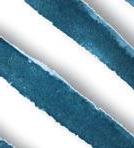




































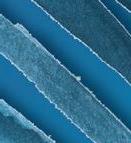





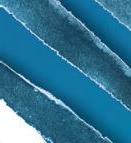




































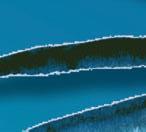







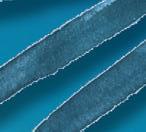









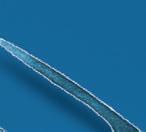













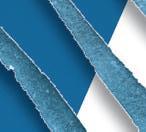






















SPONSORS Join us in Grand Cayman for the 10th anniversary of Cayman Cookout, the culinary event of the year. Hosted by Eric Ripert and a few legendary friends. Tickets available October 1, 2017 only at caymancookout.com PRESENT JANUARY 11–14, 2018 #CaymanCookout #RCMemories @CaymanCookout CaymanCookout CaymanCookoutO cial
Editor’s Letter
Working in the wonderful world of wine has its perks. This issue should be a testament for how great this life can be!
While we have covered many territories in France, this issue contains our report from our first-ever visit to Bordeaux. As I read our final stories I could not help thinking about planning another visit soon. Our first visit just scratched the surface. There are so many more appellations and chateaus to explore. So many more winemakers and chefs to meet. So many more wines to taste! C’est la vie!
Warren Winiarski has a distinguished career in the wine industry. He is the founder of Stag’s Leap Wine Cellars, whose 1973 SLV Cabernet Sauvignon famously won the Judgment of Paris in 1976 and helped California gain respect on the worldwide wine stage. While this achievement led to enormous business success, Winiarski has been transformed into an evangelist for California wines and has been a big supporter for preserving its place in history. We were honored to meet Warren and to get his take on past and current topics that pique his interest.
Wine Country International was born in New York. But after experiencing the sad events of September 11, 2001, we decided to move our family and company to the suburbs of Denver. Colorado has been our home base for the past 15 years. The weather is milder than most people expect, and the state enjoys about 300 days of sunshine per year. Most Coloradoans are quite friendly.
A lot has changed since we first arrived. Construction is booming everywhere. The food scene has transformed immensely. There are more restaurants per capita in Denver than New York City. Top Chef Season 15: Colorado Edition is in the works, filming in a Denver suburb.
Our editors also visited New Orleans to experience Emeril’s flagship restaurant. We arrived knowing the food would be great. We also discovered that Emeril’s Restaurant and its passionate Chef/Owner are pretty serious about wine!

Santé!
Christopher J. Davies @Vinotasting
3 WINE COUNTRY INTERNATIONAL Vol. 2 2017
Wine Country International Co-Founders Christopher & Darcy Davies in the cellar at Château Magnol
Wine Country International ® Magazine

Christopher J. Davies, Co-Founder, Editor & Publisher
Darcy R. Davies, Co-Founder & Design Director
William Davis, Senior Tasting Editor, CSS, CWE
Karin McLean, Managing Editor
Wine Education & Travel Editor, Ron Kapon

Lifestyle Editor, V.G. Walsh
Communications Manager, Karin McLean
Director of Photography, Christopher J. Davies
Contributing Editors: Michelle Bainbridge, Lisa Bell, Blair Bowman, Michael Long Claire Walter, Larry Wilcox
Advertising, Sponsorship: info@winecountrynetwork.com

A publication of Wine Country Network, Inc.
Christopher J. Davies, Chairman & CEO, Co-Founder Darcy Davies, President & Co-Founder
Wine Country Network, Inc.
P.O. Box 6023, Broomfield, CO 80021 Tel. 303-664-5700
www.winecountrynetwork.com
e-mail: info@winecountrynetwork.com
Address editorial inquiries to cdavies@winecountrynetwork.com

VINOTASTING Newsletter at www.Vinotasting.com
Twitter: @vinotasting
Wine Country International Magazine does not accept unsolicited manuscripts, drawings, photographs or other works. All letters sent to Wine Country Network will be treated as unconditionally assigned for publication and copyright purposes.
Contents © 2017 by Wine Country Network, Inc.
All rights reserved. Nothing may be reprinted in whole or part without written permission of the publisher.
All photography in this publication, unless otherwise noted is copyrighted by Christopher J. Davies, all rights reserved. www.daviesphotos.com
CRUISIN WORLD
14-17 Seven
WINE COUNTRY INTERNATIONAL 4 Vol. 2 2017
Contents
FOOD FOR THOUGHT
Pages
6 - 13 Denver is No Cow Town
FIRST COURSE
Page 18-20 Oysters ‘R’ Always in Season
Pages
Nights of Perfection — Bordeaux River Cruise
FEATURE Saint-Emilion




5 Vol. 2 2017
Pages 28-39
Pages 52-61
Warren Winiarski Beyond The Judgment of Paris
PASSIONS
Pages 77
Lodi has evolved into a respectable wine destination
PARTING SHOTS
Pages 40-69
Denver, Colorado is no cow town!
We have been based in Colorado since 2002. A lot has changed in 15 years. Denver is no longer a flyover city when it comes to its culinary offerings. Slow Food International took notice of Denver’s progressive culinary scene and held their Slow Food Nations event in downtown Denver in July of this year.
Cochon 555 Denver — March 2017, 5 Stars-Highly recommended!
Colorado foodies have been elated that Denver has been an annual stopover for the Cochon 555 National tour for the last several years. This year’s event was held at the Curtis Hotel in downtown Denver. The ballroom and its outdoor terrace provided a perfect venue for showcasing 1,500 pounds of heritage-breed pork raised on family farms. Cochon 555 features 5 chefs, 5 winemakers and 5 heritage pigs.
More recently, the event has added spirits and an expanded auction, including Heritage pork that is broken down during a butchering demonstration. Representing the Berkshire breed of pig raised by Mountain Primal Meat Company, the 2017 winner was Chef Will Nolan of Eight K at the Viceroy Snowmass.

This event is one of the top annual foodie events in Denver. A sister event called Heritage Fire is also done in June in Snowmass around the time of the Aspen Food and Wine Classic. Save the dates!
• Cochon 555 Denver — April 29, 2018
• Heritage Fire Aspen/Snowmass — June 16, 2018
Visit: http://cochon555.com
IL Posto Denver — 5 Stars-Highly recommended!
After 10 years at his original spot on 17th street, Milanese born Chef Andrea Frizzi made a bold move and brought his successful restaurant to Denver’s revitalized RiNo area. His new space has doubled the original capacity with a hip Milan-esque look, complete with an eye catching, spectacular octopus-like series of chandeliers handmade in Murano, a beautiful bar, mezzanine and outdoor patio space ideal for Denver’s mild and sunny days. The cuisine is original and slanted toward Northern Italy, using the freshest local and imported ingredients. Favorite dishes include tagliere, calamari stuffed with anchovy, homemade pappardelle with Berkshire pork ragu and risotto.

Jovial and attitude-free Sommelier Maxwell Koepke has created a well-thought-out selection of wines to pair with the cuisine. The list is 100% Italian, broken down by regions. Open Monday-Saturday for lunch and dinner.
IL Posto Denver
2601 Larimer St.
Denver, CO 80205
https://ilpostodenver.com
FOOD FOR THOUGHT WINE COUNTRY INTERNATIONAL 6 Vol. 2 2017
Vero — “One of the Best Pizzas in Colorado!”

Located down the block from Il Posto in the Denver Central Market is Il Posto’s sister restaurant Vero. It’s Chef Andrea’s take on Neapolitan cuisine. Vero features fresh homemade pizza and pasta dishes, plus an Italian marketplace where you can buy many imported ingredients. Its exquisitely mosaic-tiled oven is made from Vesuvian soil. Pizzas take just two minutes to cook in this 800° degree oven.
You can order food to eat communal style in the DCM’s communal-style grand hall or grab and go!
Vero
2669 Larimer St.
Denver, CO 80205
http://eatvero.com/
Atelier by Radex
Highly-acclaimed, French-trained Chef Radek Cerny is no stranger to Denver foodies. He has taken over the former IL Posto space on 17th Avenue and transformed the spot into a popular French restaurant. Chef Radek dazzles diners with his epic French cuisine, while cooking in full view, wearing his signature cowboy hat. There is no shortage of flames flaring up and incredible smells radiating from the kitchen! Couple that with an impressive wine selection and impeccable service and you are in store for an amazing dining experience. Reservations for dinner are strongly advised. Lunch service is the best-valued lunch in Denver, with most entrées priced at under $20!

Atelier by Radex
2011 E 17th Ave.
Denver, CO 80206
https://www.atelierbyradex.com/
il Porcellino Salumi — Highly recommended for meat lovers!

If you are a fan of artisan-quality, house-cured heritage meats, il Porcellino Salumi will quickly become your muststop place for salumi and charcuterie. Popular products include bison pastrami, lamb prosciutto, pork rilettes, and beef and pork fermented summer sausage. Early this year they won national acclaim for their smoked head cheese and coppa!
They offer a wide range of hard-to-get, prepackaged gourmet products, plus a deli where you can order generously portioned sandwiches.
il Porcellino Salumi
4324 W. 41st Ave.
Denver, CO 80212
http://ilporcellinodenver.com/
FOOD FOR THOUGHT 7 WINE COUNTRY INTERNATIONAL Vol. 2 2017

FOOD FOR THOUGHT WINE COUNTRY INTERNATIONAL 8 Vol. 2 2017
2017 Drink Pink Vino International Rosé Wine Competition and Festival
Wine Country International’s parent company also runs one of the only professional wine competitions focused exclusively on rosé wine. The 2017 competition received around 200 wines from around the world.
Top winners included:
• Sobon Estate Rosé 2016
• Wente Family Estates Murrieta’s Well Dry Rosé 2016
• Chateau de Campuget 1753 Rosé 2016
For the full list of winners visit: http://drinkpinkvino.com/assets/diwc_2017_awards_web. pdf
The 2017 Drink Pink Vino International Rosé Wine Festival took place on June 15, 2017 at the Omni Interlocken Resort’s Outdoor Pavilion in Broomfield, Colorado. Attendees got to taste more than 80 different domestic and imported rosé with fresh oysters, gourmet cheeses and charcuterie. A live band played jazz music and a silent auction benefiting There With Care® raised funds for a very good cause. The Drink Pink Vino International Rosé Wine Festival will return in mid-June 2018. www.drinkpinkvino.com



FOOD FOR THOUGHT 9 WINE COUNTRY INTERNATIONAL Vol. 2 2017
Cheers to the First Decade!
Fruition Restaurant’s 10th Anniversary Celebration

Story and photos by Christopher J. Davies
Good things come in small packages. Fruition Restaurant on 6th Avenue in Denver is a quaint space seating around 55 guests at a time. The cuisine features masterful farm-totable ingredients with a focus on great flavor. This highly acclaimed restaurant comes up on the top 5 Best lists for restaurants in Colorado — kudos include Food & Wine Magazine’s Best New Chef list in 2010 and a James Beard finalist nomination for Best Chef Southwest Award in 2016.
On February 6th, Fruition celebrated a major milestone for any restaurant, its 10-year anniversary. When we received the news about the special dinner, Darcy and I just had to make a reservation. Chef-owner Alex Seidel planned an intriguing menu, bringing back a highly talented group of chefs consisting of his current trusted team, as well as past employees who have advanced to the helm of their own restaurants or even the number two slot at Boulder’s eponymous Frasca restaurant. At $150 per head, this feast was an instant sellout.

We arrived at the restaurant 15 minutes early and saw a line of enthusiastic couples waiting in front for the door to open. The evening’s weather was unusually mild and pleasant for February. While we waited outside, frequent bursts of light flowed around the restaurant’s blinds — a photographer had been hired to document the evening.

FOOD FOR THOUGHT WINE COUNTRY INTERNATIONAL 10 Vol. 2 2017
We were seated in the main dining room near some familiar faces. Chef-owner Alex Seidel greeted all of the guests with warm hugs of appreciation. He explained that his kitchen felt like “a sardine can” with all of the chefs prepping their ingredients. He invited me to take a peek for myself. Sardine can confirmed! Fruition’s compact kitchen feels yacht-sized on a good day.
Like the majority of the guests, we decided to order the optional wine pairings selected by Head Sommelier Patrick Houghton. The wine picks were a virtual tour of Europe’s top wine regions, with bottles from France, Germany, Austria, Spain and Portugal. The wine pairing add-on price was a bargain at $70.
The night began with Champagne and a trio of hedonistic appetizers passed around:

• Savory Beet Entremet, Shaved Foie Gras, Yogurt Mousse, Pistachio Crisp
By Franco Ruiz (Hops & Pie, Denver,
CO)
• Rabbit Terrine, Red Cabbage, Heirloom Carrot, Micro Mustard
By Josh Rathbun (Sienna, Wichita, KS)
• Beef Tongue, Celery Root, Anchovy, Tzatziki, Marinated Vegetables, Flat Bread
By Kona Bobek (Chop Shop, Denver, CO)
Fruition staff delivered the plates in a well-timed, orchestrated manner. Course after course, wine after wine, we were very pleased with this epic dining experience.
Chef Seidel’s plate was course four, and did not disappoint. It consisted of medium-rare, succulent Peking Duck Breast, Blood Orange, Celery Root and Pomegranate. The combination of savory and sweet would have won over the likes of Julia Child.
Plate portions were petite until course five, when we received Justin Brunson’s roaring tribute to variety and luxury meats. It was a Vol au Vent (puff pastry) stuffed with Bacon, Sweetbreads, Foie Gras and Oxtail with a Newburg Sauce. Off the scale!

During the four-and-a-half hour seating, Chef Seidel revealed some interesting facts about his team and its journey. It became clear that his mentor style has made a very positive impact on so many chefs and hospitality professionals during these ten years.

Seidel credits his incredible success over the decade (later opening Fruition Farm and Dairy and Mercantile Dining and Provision) to his faithful team. A number of them graduated on to elevated positions at other haute restaurants in Colorado and abroad or opened their own places, but enthusiastically returned to celebrate Fruition’s 10th Anniversary.
Fruition
1313 E. 6th Ave. Denver, CO 80203 Tel. (303) 831-1962
http://www.fruitionrestaurant.com/
FOOD FOR THOUGHT 11 WINE COUNTRY INTERNATIONAL Vol. 2 2017
Emeril’s Restaurant, New Orleans


Story and photos by Christopher J. Davies
Darcy and I had the pleasure of visiting Emeril’s flagship restaurant in New Orleans for lunch this summer, where Emeril made his bones after his epic eight-year stint at Commander’s Palace. It is hard to imagine this restaurant’s rich history as the launch pad for the many milestones that occurred thereafter: the television shows, cookbooks, seasonings and a chain of restaurants in New Orleans, Las Vegas, Florida and Pennsylvania.
The restaurant is located about ten minutes away by Uber from Bourbon Street in the Warehouse District. Emeril’s restaurant has been a top foodie destination for over 26 years. The space is warm and spacious with elegant details and wine is a big focus, with floor-to-ceiling wine refrigerators displaying top bottles in clear view.
We decided to sample a selection of dishes from the lunch menu:
• BBQ Shrimp
• Lobster Skewers
• Cajun Caviar
• Seafood Gumbo with Andouille sausage
• Andouille-Crusted Drum
We ordered a bottle of Chablis to pair with the dishes. The massive 67-page wine list has 6 pages dedicated to white Burgundies!
FOOD FOR THOUGHT WINE COUNTRY INTERNATIONAL 12 Vol. 2 2017
It was no surprise that these dishes created by the king of “Bam!” would be so packed with flavors and perfectly cooked. The Cajun Caviar was a really unique dish — Emeril’s reinterpretation of a Cobb Salad. Emeril’s contained spicy lobster caviar on top of finely chopped beets, dusted with dry ghost peppers. The textures and lingering heat were an amazing combination!
After lunch, we had the pleasure of sitting down with Sommelier Ray Gumpert, a long time Emeril employee who has a major influence over Emeril Restaurant’s wine program. Emeril’s flagship restaurant has 20,000 bottles to choose from. We brought up the white Burgundy section of his wine list.
“Our food needs wine that has power and acid. The white Burgundies are frequent customer favorites!” remarked Gumpert.
To our surprise, Ray broke out a few special bottles he has personally selected for Emeril’s wine program.
AldenAlli Pinot Noir is a joint wine project between the Lagasse and Kosta families. Dan Kosta of Kosta Browne fame is a longtime fan of Burgundy wines. Over the past twenty years, Kosta Browne has enjoyed enormous success as one of the leading producers of Pinot Noir in California.

AldenAlli is named after Emeril’s and Dan’s wives, Alden Legasse and Allison (“Alli”) Kosta.
AldenAlli 2013 Sonoma Coast Pinot Noir, $80 Restaurant Price, 4.5 Stars!
This wine is aged in 40% new French/60% neutral French oak for 10 months.
Deep garnet with hints of cranberries, star anise and dark cherries. This wine has Dan Kosta’s thumbprint all over it! A perfect food wine for pairing with Emeril’s cuisine! Limited availability at http://www.aldenalli.com/
Another collaborative wine between Ray Gumpert and Seamus Wines is the 2013 Hoj-Poj Sonoma Red, $40 Restaurant, 4.5 stars. It pays homage to Emeril’s Portuguese roots and is a blend of Touriga Nacional 65%, Tinto Cao 21% and Tinta Roriz 14%. It is a fun wine that sells at the restaurant for $40 a bottle. “I like selling it at the restaurant because it makes people smile”!
Emeril’s is a must for any food and wine lover. The food portions are generous and the wines and cocktails are well thought out to make your dining experience sensational.
Emeril’s Restaurant – 5 Stars!
800 Tchoupitoulas St.
New Orleans, LA 70130
PH: 504 528 9393
http://emerilsrestaurants.com/emerils-new-orleans

FOOD FOR THOUGHT 13 WINE COUNTRY INTERNATIONAL Vol. 2 2017
Seven Nights of Perfection — Bordeaux River Cruise
 By Ron Kapon
By Ron Kapon
Having traveled to 149 countries in my 82 years, I consider myself a perfectionist. I am always looking for faults and/or problems during my travels. The room and/or bathroom was not clean; the front desk staff was not helpful; the drivers (taxi, car service, tour buses) were non-caring; the food was overpriced and of poor quality, etc. I rate a trip on a 0-5 scale. It is tough to get a zero or a five. I recently returned from a two-part trip to France. Viking River Cruises invited me on a seven-night Bordeaux River Cruise. They gave me a single cabin on the Viking Forseti, plus roundtrip transportation on Air France. I added a two-night stopover in Paris before the river cruise.
My Air France flight arrived at 5:30 a.m. and the pre-arranged group ground transportation pickup (I was the only passenger) to my hotel arrived after a 20-minute wait. I later found out there was a strike by gasoline delivery workers and gas stations had long lines. My driver was waiting in one of those lines.
I had booked the 3-Star Hotel des Batignolles in the 17th Arrondissement on a recommendation from the French Tourist Office. Conveniently, the hotel was only a few blocks from the #11 bus line I used twice, there was a deli next door to the hotel and a block away were two well-priced cafés. There was no elevator or air-conditioning, but on request they gave me a first-floor room (of 48 total) and a fan. The price was right ($125 US, which included the $12 US breakfast). My room was not ready (it was 7:30 a.m. when I arrived) so I headed downtown for my bus tour. Because I arrived before the visitor’s center opened, I walked around the neighborhood (Le Printemps also was not open). At 9:30 a.m. I started my tour on the Green Line, which included most of the main tourist attractions — Arc de Triomphe, Louvre Museum, Eiffel Tower, Champs-Elysees, Notre Dame Cathedral, Place Vendôme, Place de la Concorde, etc. After more than two hours, I switched to the Orange Line, which took me to Place Montparnasse, Rodin Museum and the Latin Quarter. The Yellow Line included Moulin Rouge, Opera Vendôme, Montmartre and the North and East Railroad stations. I skipped the Blue Line (Place de la Bastille, Luxembourg Gardens and Pantheon) and headed back to my hotel to check in and unpack with an early bedtime (I can’t sleep on airplanes). Sixteen hours later I awoke to pouring rain, which unfortunately meant no more open airbus or river cruise.
I worked at the hotel, had a wonderful early dinner at the bistro and it was another early night. The hotel arranged a different group pickup service (also more money). This time there were six other people on the van. I used the Air France airport lounge for breakfast because we left before the 7 a.m. start time for breakfast. Viking representatives were waiting outside baggage claim and loaded us into their bus. In half an hour we arrived at the dock and it was all aboard the Forseti. Garonne River Gauche Quai des Chartrons.
The previous cruise (like ours) had the 190 passengers off the ship by 10 a.m. so the rooms and public areas could be cleaned. The Forseti is 443 feet long with 95 cabins. My cabin #325 was ready and in a few minutes my luggage arrived. The king bed (two twins put together) took up most of the room. There were two side tables and a sideboard that ran the length of the cabin, with a fridge and drawers for clothes, as well as a desk with a bench and a large-screen Sony TV. The closet had room for my hanging clothes as well as a safe. To conserve electricity, one’s room key was used to control the lights and power. When one left the room and removed the key, the lights and air-conditioning went off. My first meal was a lunch buffet in the lounge area (3rd floor, same as my room level). The library and two computers were located there as well as the best Wi-Fi signal,
CRUISIN WORLD WINE COUNTRY INTERNATIONAL 14 Vol. 2 2017
which did not work in the staterooms. If we did not want the breakfast and lunch buffets in the second floor dining room (dinner was from a menu), one could eat at the far end of the lounge, both indoors and outdoors, with lighter fare. I tried it several times.

There were three floors of rooms, with the first level having only a porthole whereas the second- and third-floor rooms had small balconies with two chairs and a small table. One side of the ship had mini-suites. The top deck was partially open for relaxing. The Captain also had his operation room there. There was a scheduled city walking tour in the afternoon, but it was cancelled due to the pouring rain. I used the free time to explore the ship and book several additional tours. Journalists traveling as guests of Viking are given a $200 credit to use for optional tours, which are offered every day and included in the cost of the trip. In addition, there is a varied choice of optional tours available at additional cost.
Note: I spoke to a couple that had the same level cabin as I and paid around $7,000 for both (2 for 1 deal) with airfare from New York and gratuities included. I paid about $125 US in gratuities divided among all the employees (room attendant, wait staff, ship’s crew). Only the Social Director



CRUISIN WORLD 15 WINE COUNTRY INTERNATIONAL Vol. 2 2017
had a suggested gratuity separate from everyone else, which I found strange since she was part of management that included the chef, food and beverage director, captain, first officer, housekeeping director, general manager and front office manager. Also note: wine, beer and soft drinks are complimentary with on-board dinner and lunch. They also have the Silver Spirits Beverage Package that included most spirits, mixed drinks and premium wines at $30 per person per day. The rest of us had a white and red house wine as well as non-alcoholic beverages with meals.
Dinner started at 7 p.m. I decided to sit with different people at meals since I wanted to see where guests came from and also if they had been on a Viking River Cruise before. There were many doctors, lawyers and retired folks, mainly from the United States. Several were veteran Viking customers. There were several interesting coincidences. I ran into John Helion who had been the assistant wrestling coach at Columbia, my alma mater, 30 years ago. My next-door cabin mate went to Columbia in the same class as my younger brother. Another passenger recognized my name. We were in the same fraternity at Columbia (a few years apart). It had stopped raining when I went on the evening stroll (2 ½ hours).
This was the last night of the River Festival and we stopped at Place de la Bourse to watch the fireworks. The Fontaine des Trois Graces is at the center of the square. We then took a tram back to the ship. The modern tram system began operation in 2003 and now covers 41 miles. It uses ground-level power supplies that avoid overhead wires. A ticket costs about $1.65 US.
Sunday morning we had a three-hour city tour by bus and foot. Included was an inside visit to the Museum of Aquitaine that highlights the history of Bordeaux. We spent some time

at the Places des Quinconces, one of the largest squares in Europe. The city of Bordeaux has a population of about 250,000 and is visited by over six million people a year. The required safety drill followed lunch. When I asked where the lifeboats were, Captain Chazot laughed, because for most of our trip the water wasn’t deep enough for the boat to sink. My third floor would still be above water and the crew would have us jump in and walk to shore. We left Bordeaux at Noon for Cadillac, cruising the Dordogne and Garonne Rivers and arriving at 3:30 p.m. Later in the afternoon we went for a Sauternes tasting. Dinner was followed by a wine lecture in the lounge, showing the different Bordeaux varieties.
Monday morning we had a Cadillac city walk. It’s a charming city directly across the Garonne River from Sauternes and is known for producing sweet dessert wines under the Cadillac AOC designation. At 10:30 we left for Libourne. The free time before lunch was my opportunity to interview both the chef and food and beverage director. Chef Cesar Mata was born in Portugal and attended the Lisbon Hotel School. He has worked at the Ritz Hotel Lisbon and for 5 years was at Caesar Park Hotel in London, followed by 11 years at Marriott. He has been the part-time chef for the Portuguese national soccer team for eight years. This is his second year with Viking. He likes the fact that he gets time off for family visits. Food and Beverage Director Imre Csongradi has a wife and young daughter in Budapest. He attended the Hungarian Economic University. He has worked on the Celebrity Saltise and at the Four Seasons in Budapest, plus one year in
CRUISIN WORLD WINE COUNTRY INTERNATIONAL 16 Vol. 2 2017
Dubai. 3½ years ago he joined Viking and again he liked the time off to spend with his family. He worked on the North Seine, Rhone and now the Bordeaux cruise.
After lunch the chef had a cooking demonstration on making macarons — my nut allergy prevented me from tasting any. Before dinner there was a Bordeaux presentation. I discovered my room TV had a channel for the lounge. When I wanted to stay in my cabin I could still watch the presentations. Every evening right before dinner the Social Director gave a presentation outlining the following day’s program.
We overnighted in Libourne, arriving at 7:15 p.m. The next day was my first optional tour, a full day (9 a.m.-5:30 p.m.) of lunch and a tasting of the wines of Pomerol and St. Emilion. Our lunch was at Chateaux Siaurac with the proprietor Paul Goldschmidt. There was a 1½ hour walking tour of Libourne, including the farmers market. A walking tour of St. Emilion followed. I visited the church and then broke off from the group for a trolley ride through the vineyards ($10). The city of St. Emilion (another UNESCO World Heritage Site) had a lot of hilly streets with cobblestones throughout. After my trolley ride I took a short walk through the local wine shops near our bus location. Somehow a couple got lost and missed the bus back to the ship. We left for Bourg at 6 p.m., arriving at 8 p.m., where they caught up and joined us.
On day five we had a Blaye City Walk at 9 a.m., including a visit to the Citadelle de Blaye, a UNESCO World Heritage Site. This was part of my second optional tour to Cognac. We went to Caymus, which is privately owned. Hennessy, Courvoisier, Remy Martin and Martell produce 85% of the world’s Cognac, with Hennessy being the most predominant. After learning the distillation process, we blended our own Cognac from the four mail regions. Mine was 20% Fin Bois, 15% Borderies, 30% Petit Champagne and 35% Grand Champagne.
Day six we left Bourg at noon. I walked a few blocks into town but there was really nothing to see or do. We cruised the Gironde River and arrived in Pauillac at 1:30 p.m. After lunch (2:30-6 p.m.) the passengers split into four groups, each to visit different Margaux chateaux. Mine was Giscours. There was a photo opportunity at Chateaux Margaux and we all met at 5:30 p.m. at Chateaux Kirwan for dinner. The chef and dining room staff brought everything needed to Kirwan. The only thing missing was air conditioning; it was warm inside the dining room.
On our last full day there was a change of plans. We left Pauillac very early (5 a.m.) because of a change in tides, and arrived in Bassens, an industrial park, at 9 a.m. I cancelled my private tour of Lafite Rothschild since we were now an hour away. It should have been 10 minutes if not for the tidal changes, and a taxi would have cost me $75 each way. We arrived back in Bordeaux at noon. I learned that the city was also a UNESCO World Heritage Site. After lunch I walked the half-hour along the Chartron to my appointment at the City of Wine. This futuristic structure is one year old and has already been visited by over a half-million people (80% French with the rest mainly from the U.S. and Great Britain). On the main floor there is a bookshop, wine bar and casual restaurant. The wine boutique has over 14,000 bottles from 80 countries. On the second floor there are exhibition spaces, including a circular room with 360-degree projections plus an explanation of the entire wine process. Everything there is interactive. The
8th floor has a wine bar with a glass of wine included in the price of admission ($22.50 US). Everything in between is office space There are fabulous views of the Garonne River and the Port of Bordeaux. I rode the tram two stops back to the ship.
http://www.laciteduvin.com/en

Our farewell toast by the executive staff was followed by our final dinner. Saturday morning it was bags outside the door and we were off to the Bordeaux airport. In Paris, there was a layover of a few hours before my return flight to JFK. Thank you Air France for allowing me to use your lounge!
Trip overall — Five Star plus. Great food and lots of wine (I never eat three full meals at home). I will get on the scale in a day or so but am afraid to look. Every employee was friendly, helpful and courteous. I was told they choose less experienced workers who have a winning personality and then train them. Most of them are eastern European — Bulgarian, Croatian, Serbian etc.
https://www. vikingrivercruises.com/cruise- destinations/europe/chateaux- rivers-wine/2017bordeaux- saint-bordeaux/index.html
CRUISIN WORLD 17 WINE COUNTRY INTERNATIONAL Vol. 2 2017
Oysters ‘R’ Always in Season
By Claire Walter
Once, conventional wisdom dictated that oysters only be eaten in months with R in them. That time is long past. Oysters are a year-round delicacy from coast to coast, though summerharvested bivalves simply don’t taste as good as the cold-weather, cold-water sorts.
Oysters were once so abundant on American shores they were known as the “poor man’s fish.” Oysters were drastically afflicted by over-harvesting, predators and pollution, but now, long-time oystermen and newbies too are farming oysters responsibly. Currently, this aquaculture crop is cultivated and harvested and is a delicacy. There are scores of varieties, from the Apalachiocola of the shallow waters off the Florida Panhandle to the Zen oysters from the deep waters of the British Columbia coast. Oysters fall into five broad categories. Pacific oysters are the world’s most cultivated variety. Kumamotos, originally from Japan, are now raised both there and on this side of the Pacific Ocean. Tiny Olympic oysters are native to the Pacific Northwest. European Flats originated in France, where the most famous variety is the Belon — a type now gaining favor on the East Coast too.
Dining Out on Oysters
Restaurants in this country have been serving oysters for nearly two centuries. Boston’s Old Union Oyster House, a National Historic Landmark, has been shucking and serving these magnificent mollusks since 1826.

Alciatore Antoine immigrated from Marseille to the young United States in the early 19th century. In 1840, he opened Antoine’s in New Orleans, where he created a decadent dish called Oysters Rockefeller — served on the half-shell, topped with spinach or other greens, butter and breadcrumbs and baked or broiled.
When the respected website Eater New York listed restaurants popular with tourists but appealing to fussy locals as well, New York’s Grand Central Oyster Bar was on the short list. It opened in 1913 and is the city’s bestloved mecca for oyster lovers. Its oyster stew is the stuff of legend.
WINE COUNTRY INTERNATIONAL 18 Vol. 2 2017 FIRST COURSE
“He was a bold man that first ate an oyster,” opined Jonathan Swift, the satirist whose writing four centuries ago displayed biting wit. Many would agree that the homely bivalve is not an object of conventional beauty. Its beauty comes from its fresh, briny taste that carries the essence of the sea.
Shucking-Oysters.-Hog-Island-Oyster-Bar-San-Francisco Photo Credit: Ed-Anderson

IN MORE PLACES. We welcome you in more than 50 Aeromexico Salon Premier and Delta Sky Club® airport lounges in the United States and Mexico. *For international flights, access to Aeromexico’s VIP Lounges is exclusive to passengers of Delta One® and SkyTeam® Elite Plus members.
NOW , FEEL AT HOME
FIRST COURSE
The Walrus & The Carpenter in Seattle’s Old Ballard ‘hood has been packing ‘em in since it opened in 2010. By that time, Casamento’s in New Orleans had been serving oysters for nine decades. Their char-broiled oysters are faves.
P&J Oyster Company is a family business in New Orleans tracing its roots back to 1876. The family-owned company cultivates and harvests oysters at the mouth of the Mississippi and ships them out of an old warehouse in the French Quarter. It has published The P& J Oyster Cookbook, known equally for its beautiful photographs and its recipes.




The Hog Island Oyster Company farms oysters in Tomales Bay in northern California. It operates a bay-view seafood bar right on the water, as well as a popular, full-service restaurant in San Francisco’s Ferry Building. The view is of the Bay Bridge and the oysters are just as fine as those up the coast. “Oysters are the most tender and delicate of all seafoods. They stay in bed all day and night. They never work or take exercise, are stupendous drinkers, and wait for their meals to come to them,” wrote Hector Bolitho in The Glorious Oyster.
Tamar Haspel and Kevin Flaherty are relative newcomers to oystering. They are cottage farmers on Cape Cod, where they started raising their own chickens, catching their own fish, growing their own tomatoes and hunting for their own venison, and they now operate an oyster farm where they grow about 50,000 oysters a year in the beautiful coastal waters.
The bottom line, though, for all of us is the sheer appreciation of oysters. Whether you slurp ‘em raw at a seaside shack, delicately dine on them in a fine restaurant or toss ‘em on the grill, oysters are improbably delicious. One more thing: Don’t expect to find any pearls.
WINE COUNTRY INTERNATIONAL 20 Vol. 2 2017
Top Photo: New York’s Grand Central Oyster Bar’s Oyster Stew Photo Courtesy of Grand Central Oyster Bar
Photo to the left: P&J Oyster Company Delvivery
Photo Credit David Grunfeld
Photo to the Left: Boston’s Old Union Oyster House Photo Courtesy of: Boston’s Old Union Oyster House
Photo to the right: The Walrus & The Carpenter’s fresh oysters of the day
Photo Courtesy of: The Walrus & The Carpenter
Benefiting: Produced by:



























21 WINE COUNTRY INTERNATIONAL Vol. 2 2017 FIRST COURSE
Denver’s Brown Palace Is Still Going Strong After 125 Years!

Vol. 2 2017 WINE COUNTRY INTERNATIONAL 22 DESTINATIONS
Story and photos by Christopher J. Davies
I first visited the Brown Palace Hotel and Spa in 2003 for an afternoon meeting with 10th generation Austrian Glass Master Georg Riedel in the Churchill Bar. There Georg had a sommelier decanting a terrific bottle of 1992 Clos des Lambrays Pinot Noir from Burgundy ($650). I learned that Georg was a frequent guest at the Brown Palace, passing through Denver quarterly on his way to conduct Riedel Glass tasting seminars in Vail and Aspen. The Churchill Bar is the Denver business dealmaker’s favorite hangout with a terrific stock of whiskey and cigars, and is one of the last places a gentleman or woman can smoke a stogie indoors.
Over the past 15 years I have attended numerous wine and food receptions at the Brown Palace. One of the most spectacular annual events is the Champagne Cascade Ceremony held every November. Now in its 30th year, the event kicks off the holiday season. More than 6,000 champagne glasses are assembled in a Christmas tree-like fashion. Champagne is poured into the glass two stories high and cascades down into the other Champagne glasses below. It must be nerving racking on the staff to balance that many glasses without having an accident. But to add to the drama of the afternoon a professional master saber will conduct a sabering demonstration to sever off the bottlenecks of Moët & Chandon Champagne bottles.

The Brown Palace Hotel and Spa recently celebrated its 125th anniversary in glorious style, and has invested more than $10 million into renovations. The hotel has 241 guest rooms, including three presidential suites and The Beatles suite. Yes the Fab Four and many other rock stars and presidents have stayed here! Room rates range from $199 to $500 and suites from $500 to $1,600 per night. The hotel has enjoyed a Forbes Four Star and a Mobil Four-Star rating as well as AAA’s Four Diamond rating for more than 30 consecutive years. Colorado Springs has the Opulent Broadmoor, but in the city of Denver, The Brown Palace is the crème de la crème of luxury resorts.
The spectacular triangle-shaped building exterior juts out in Denver’s skyline like New York’s Flatiron Building. When you enter the lobby for the

Vol. 2 2017 23 WINE COUNTRY INTERNATIONAL DESTINATIONS
“The secret to a successful sabering is to freeze the bottle necks the night before so that the severing can occur at the bottle seam,” advises Madeleine de Jean (a.k.a. Madame Champagne)
first time it is hard to take in all of the contents of its substantial 8-story atrium with stained glass ceiling.
A lot of terrific additions and new programs have been added this year, including the new Executive Chef Timothy Ralphs, a seasoned fine dining chef with culinary experience in Europe, Asia and California. Chef Ralphs had a career milestone when he was invited to cook a dinner at the James Beard House in 2014, and he is already having a positive impact on the hotel’s culinary offerings. Together with recently-hired Food and Beverage Director Udit Dang, the pair is elevating the culinary and beverage offerings to new heights. Udit is working with his sommeliers to maintain a collection of fine wines to celebrate every occasion.
Some of the top bottles include:
• Domaine de la Romanee Conti
• Corton, 2010
• Échezeaux, 2011
• Échezeaux, 2012
• Château Petrus, 1985
• Château Cheval Blanc, 1998
• Château Figeac, ler Grand Cru Classé, 1995
• Château Cos d’Estournel Deuxieme Cru, 1982
• Château Cos d’Estournel Deuxieme Cru, 1995
Director of Marketing and Sales, Mark Shine, pioneered some unique partnerships with local distillery Stranahan’s and the Strange Craft Beer Company to create customized products to celebrate the 125th anniversary. Stranahan’s distiller Rob created special edition whisky using water from the Brown Palace artesian well water. Strange Craft Beer Company has made a limited edition beer using homemade honey that is produced at the hotel’s rooftop beehives.
The Brown Palace Hotel and Spa offers seven dining options (including in-room-dining)

– Palace Arms, Ellyngton’s, Ship Tavern and Churchill’s, plus a lobby coffee shop, and afternoon tea and cocktail service in the lobby atrium. If you are staying over a weekend, don’t miss their world-famous Champagne Sunday Brunch at Ellyngton’s. It features a colossal amount of food plus several tiers of Champagnes and Sparkling Wines.
Brunch Cost: $54 per person (plus tax & tip)

Champagne Brunch Tiers:
• Dom Perignon ($315 extra per bottle)
• Domaine Chandon ($10 per person)
• Moët & Chandon ($20 per person)
• Brunch sans Champagne
See full menu here:
https://df5ip8ns34i1i.cloudfront.net/brownpalace.com-3811616675/cms/ pressroom/ellyngtons_brunch_menu.pdf
With all of the fantastic food and beverages, you will need to consider visiting the health club facilities or take a quick jog over to the State Capital Building.
The Spa Facilities are also not to be missed. The Brown Palace Spa is two stories high and may be accessed from the main lobby. It features a private couples suite with a dual reclining hydrotherapy tub; six massage and skin treatment rooms; separate men’s and women’s locker rooms with relaxation areas; Swiss showers; steam rooms with aromatherapy; and a nail and hair salon.
Brown Palace Hotel & Spa
321 17th St
Denver, CO 80202
Tel. (303) 297-3111
https://www.brownpalace.com/
Vol. 2 2017 WINE COUNTRY INTERNATIONAL 24 DESTINATIONS

Vol. 2 2017 25 WINE COUNTRY INTERNATIONAL DESTINATIONS

Vol. 2 2017 WINE COUNTRY INTERNATIONAL 26 DESTINATIONS
INTERVIEW WITH TIMOTHY RALPHS
EXECUTIVE CHEF AT THE BROWN PALACE HOTEL AND SPA
CD: How are you doing?
TR: I am doing well.
CD: Thanks for taking the time to sit down with me. I know that you are busy.
TR: There’s a lot going on here during the next 10 days!
CD: How long have you been here at the Brown Palace?

TR: It has been about 8 weeks.
CD: There has been a lot going on since you arrived.
TR: Yes! I have been thrown into the deep end of the pool right away!
CD: Sometimes that is good!
CD: We were photographing a couple of the new dishes here for our magazine. Tell us about the first one with the lobster.
TR: The first one is a contemporary play on a classic pairing of lobster and melon.
We use our Colorado sugar melons, cantaloupes and two different varieties of lobster. As well as caviar and sturgeon roe. It is a very nice pairing. We have added herbs and micro-greens as well. It is just a beautiful little plate.
CD: I love the presentation in the caviar tin. I thought that was brilliant.
TR: It makes it fun!
CD: And then the other dish…a Beef Wellington?

TR: Certainly a classic Wellington. You don’t become One Hundred and Twenty-Five years old without having some of the classics. With the anniversary coming up we are focusing on some of those traditional dishes. We have put a little contemporary spin on with some Yukon Gold potato puree, truffles and zucchini and some fresh morels to round out the plate.
CD: Are the morels from Colorado?
TR: They are. They are from thirty miles away.
CD: You mentioned to me that you last worked in Palo Alto, California.
TR: Correct.
CD: How do you compare the fresh ingredients in Colorado to what you had available in California?
TR: I am a California kid. There are a lot more fresh ingredients in California. But Colorado has a lot that people don’t always recognize.
Right now we are getting Heirloom tomatoes, sugar melons and Palisade peaches. There is really a lot to offer.
CD: We are really lucky to have Palisades peaches available. In that neck of the woods there is also wine country. Have you had a chance to try any Colorado wines?
TR: Yes. I have tried a couple.
CD: How many restaurants do you have at the hotel?
TR: We have three main restaurants. The Palace Arms, We have Ellyngton’s, where we serve breakfast and lunch, including our award-winning Champagne brunch every Sunday. And the Ships Tavern as well. We also do a wonderful afternoon tea in the lobby. We have our Churchill’s Bar, which is also quite special as it is one of the few places in Colorado where you are allowed to smoke cigars.
CD: Wow you could never do that in Boulder!
TR: It is one of the joys of being 125 years old. We are grandfathered in. It is a great venue especially at night. Great ambience and if you love a cigar this is the place then come and enjoy it here.
CD: What are some of your other traditional dishes?
TR: Eggs Benedict, Fish and Chips, Prime Rib at The Ships Tavern has been a staple here at the hotel for longer than I have been alive. It’s fun!
CD: What do you have planned for the future?
TR: We are busy with the anniversary. We are looking at some new items in the future. But for now we want to hold onto the tradition of this magnificent place!
Vol. 2 2017 27 WINE COUNTRY INTERNATIONAL DESTINATIONS
Feature : Banking on Bordeaux




WINE COUNTRY INTERNATIONAL 28 Vol. 2 2017
Bordeaux is the world’s most famous wine region. It is the ultimate wine destination, with 56% of its 6 million annual visitors coming to visit chateaus and taste wine, a lot of good wine indeed.

29 WINE COUNTRY INTERNATIONAL Vol. 2 2017
Story and photos by Christopher J. Davies. Additional photos by Darcy R. Davies
Feature : Banking on Bordeaux



WINE COUNTRY INTERNATIONAL 30 Vol. 2 2017
It is the place where wine blending has become the standard for producing red wines. Its most famous chateaus — Domaine de la Romanée-Cont, Lafite, Petrus, Mouton Rothschild, Latour, Haut-Brion, Palmer and Margaux — set the gold standard for fine wine with ageability that can on average lay down for 30 to 50 years. In 2016, 10 bottles of Chateau Mouton Rothschild 1945 sold in New York for $343,000, according to Sotheby’s. In recent years, Bordeaux producers and negociants have focused on the emerging wine markets in Asia, expanding sales and helping to maintain a strong demand for Bordeaux wines.
This past June, Darcy and I had the pleasure of visiting Bordeaux for the first time. Having been a convert to Bordeaux varietals since my twenties, it seemed like a rite of passage for me to finally check this trip off my bucket list.
We decided to attend the VinExpo show in Bordeaux, one of the world’s largest trade shows for wine and spirits, with more than 45,000 attendees from 150 countries. The show is limited to members of the trade and media. While it is virtually impossible to visit every booth, the wines discovered and contacts made during this 4-day show made it an enormous success for us.
We met producers from France, Italy, Uruguay, Austria, Germany, Chile, Argentina and the United States. A big highlight was tasting the 2016 vintage of the Union of the Grands Crus of Bordeaux, an organization of one hundred and thirty-four chateaus.
Getting There:
Getting to Bordeaux is normally pretty stress free. Most folks fly into Paris and take a short one-hour flight to Bordeaux. During the time of VinExpo, however, you will find that many flights are fully sold out. As an alternative, you can take a high-speed TGV train from Paris Montparnasse Train Station to the Bordeaux Saint-Jean Train Station. Recently, TGV increased the speed of this high-speed route to take 1 hour off the previous travel time. The new TGV train service from Paris to Bordeaux takes only about 2 ½ hours. The trains are modern, clean and comfortable. The dining cars offer decent snacks, water, beer and wine.
Cost: €111 (Economy Class) to €248 (Premier Class) each way. The ride is comfortable and scenic. If you are in a rush, consider that the cost for flight is comparable to the cost of traveling by train.
Where To Stay:
There are many hotel options in the city of Bordeaux but during the time of the VinExpo show many hotels are sold out and if you find one with availability you will pay escalated, sky-high rates. Luckily we found a newly-built Residhome Hotel, with apartment-style rooms near the Port De Bordeaux, just one block from the banks of the Garonne River, with stunning views of the modern Pont Jacques Chaban-Delmas vertical-lift bridge. There are many great shops and restaurants along the river. The hotel was also located just one block from a Tramway stop (with direct access to the city center) and two blocks from the modern La Cité du Vin wine museum. This area of the city is undergoing multiple ambitious redevelopment projects, and the skyline is littered with massive construction cranes.
Residhome Bordeaux
87 Quai de Bacalan
33300 BORDEAUX
Tel : +33 (0)5 57 00 67 50
Fax : +33 (0)1 53 23 38 49
http://www.residhome.com/uk/hotel-residence-aparthotel-bordeaux-293.html

*Average Annual Cost Per Night: €92
*We paid €222 during VinExpo (June 18 to 21, 2017)
31 WINE COUNTRY INTERNATIONAL Vol. 2 2017
Feature : Banking on Bordeaux - Tour De France
VinExpo Bordeaux 2017

Trekking through the exhibition halls of the VinExpo show can be daunting. There were 2,300 exhibitors from 40 countries! Bordeaux in June can be very hot and humid. On our first day of the show the weather was 105° F at noon! In the evening, the weather starts to cool down and the gentle breezes of Bordeaux’s maritime climate kick in to make things more comfortable.
If you are lucky enough to get an invitation to some of the off-site industry only after events, you can gain access to premium wines and some of the wine industry’s power players.

16th Tour De France des Appellations
Honoring Angelo Gaja

Domaine De Chevalier, Léognan (Graves) http://www.domainedechevalier.com/en-grand-cru-classe-degraves
This annual event featured some of France’s top wine producers from Champagne, Bordeaux, Burgundy and Loire Valley. This year select trade and media were invited to honor Angelo Gaja, “Mr. Barbaresco,” an Italian wine industry legend, who is credited for transforming the reputation of Piedmont and Italian wines as a whole on the world stage. His family’s winery was founded in 1859. Today his daughter Gaia Gaja runs the company. They have 245 hectares of vineyards in Piedmont, Bolgheri and Montalcino. Just 8% of their 970,000-bottle production is white wine.
During his illustrious career, Gaja spent a lot of time in France studying vineyard practices and wine making techniques, later adopting many of these concepts and planting Bordeaux varietals in Italy.

The enchanting evening included rare magnum tastings, caviar and oysters, followed by a wonderful sit down dinner in the winery. Meeting Angelo and tasting his wines with him was a major highlight of the evening.

WINE COUNTRY INTERNATIONAL 32 Vol. 2 2017
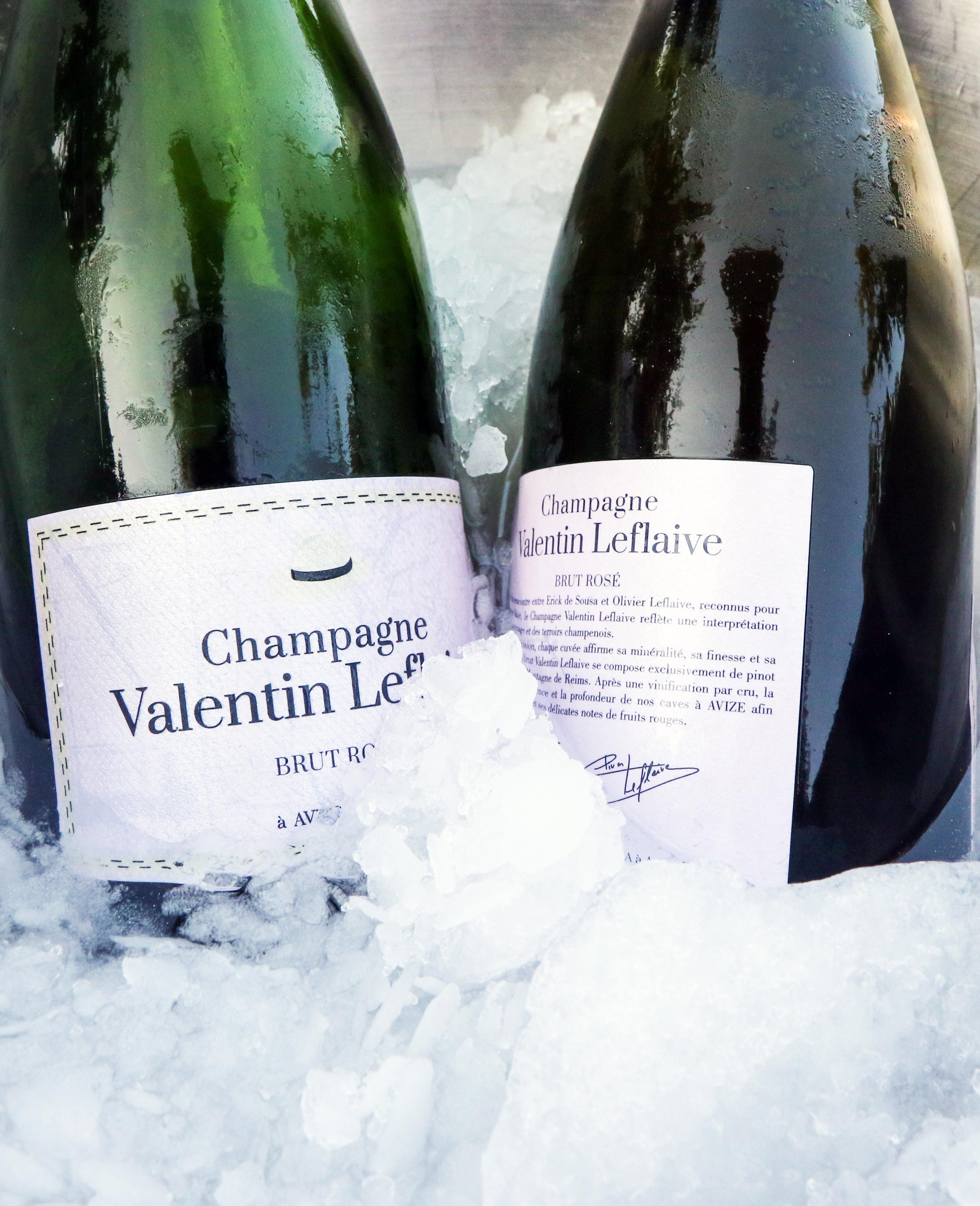
33 WINE COUNTRY INTERNATIONAL Vol. 2 2017
Feature : Banking on Bordeaux - Château Magnol

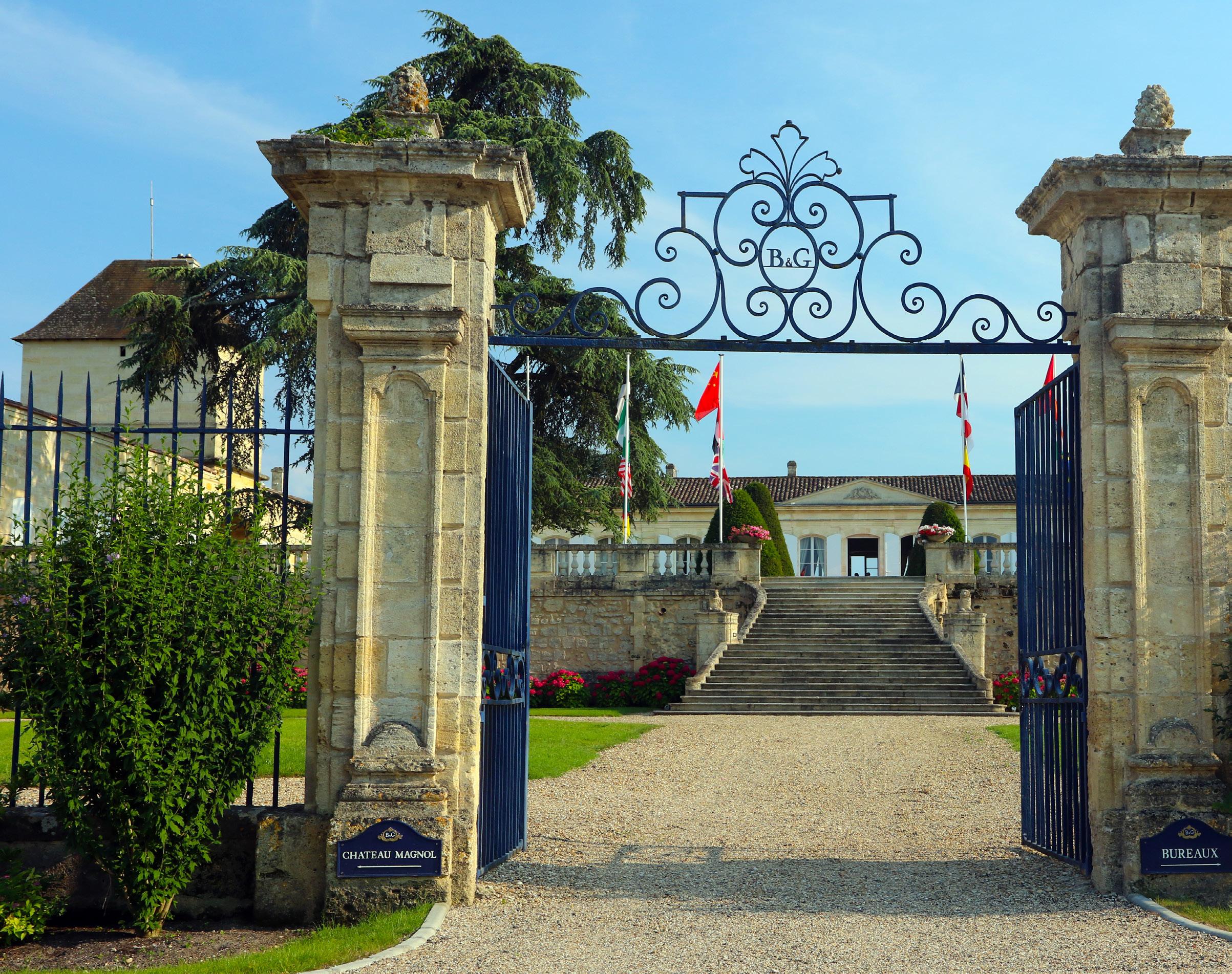


WINE COUNTRY INTERNATIONAL 34 Vol. 2 2017
Château Magnol
Darcy and I were honored to be invited to visit Château Magnol by the managers of Barton & Guestier (aka B&G). We met B&G Head Winemaker Laurent Prada and U.S. importer Hubert Surville at the B&G booth at VinExpo. There we were joined by Petra Frebault, the company’s Communications Manager, for a tasting of the newly released M de Magnol and Bistro wines. The wines sport a new modern looking packaging and feature more fruit driven, food friendly wines.
The range consists of:
•AOC Bordeaux Red (70% Merlot/30% Cabernet Sauvignon) ****1/2
•AOC Bordeaux White (1005 Sauvignon Blanc) ****1/2
•AOC Bordeaux Rosé (100% Cabernet Franc)*****
Suggested retail: $12 to $15
Also introduced:
•B&G Bistro 2016 Pinot Noir $11.99 ****1/2
After the tasting, we left the exhibit hall and drove a quick five minutes to Château Magnol where we met B&G staff members and sales representatives for a tour of the estate, aperitifs and a delicious celebratory dinner.
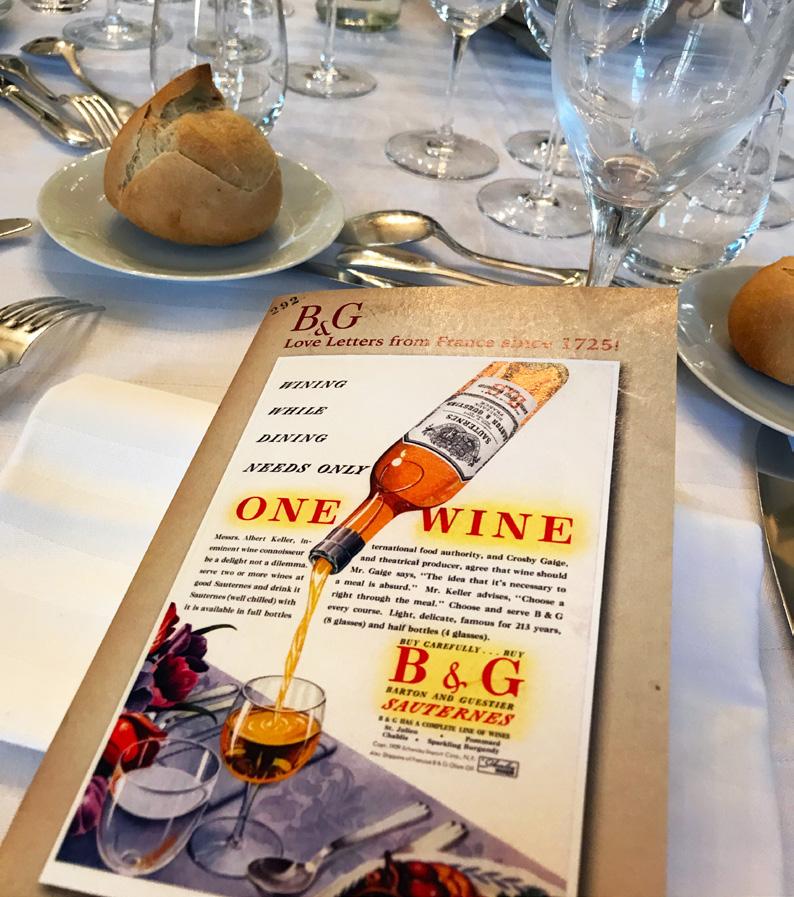
Barton & Guestier was founded in Bordeaux in 1725. Today the company is a leading producer of AOC and varietal wines from France’s top regions: Bordeaux, Loire, Burgundy, Beaujolais, Rhône Valley, Languedoc, Provence and Gascony.


Château Magnol is also known worldwide as the heart of Barton & Guestier: hosting the company headquarters, a famous guesthouse with its legendary Chef de Cuisine Frédéric Prouvoyeur and a true wine school. The B&G Food and Wine Academy which offers wine educational programs, cooking classes and wine and food pairing courses for consumers and the trade. The guesthouse has twelve elegant sleeping rooms that are used to host B&G trade clients and visiting employees from around the world.
The historical property has an amazing underground wine cellar with a colossal collection of old bottles from many of Bordeaux’s most famous Chateaus. The adjacent bunker is said to be the site of where a World War II firing squad executed several people.

B&G has recently been listed #4 in Market Watch Magazine’s 2016 Imported Wines Hot Prospects List. https://www.barton-guestier.

35 WINE COUNTRY INTERNATIONAL Vol. 2 2017


WINE COUNTRY INTERNATIONAL 36 Vol. 2 2017 Feature : Banking
Bordeaux - Château Magnol B&G has recently been listed #4 in Market Watch Magazine’s 2016 Imported Wines Hot Prospects List.
on



37 WINE COUNTRY INTERNATIONAL Vol. 2 2017
Feature : Banking on Bordeaux
Bordeaux Food
There are many, many restaurant choices. Odds are that if you are having lunch or dinner, some version of foie gras will be on the menu. Expect fresh seafood, local meats and fowl to be among the featured plates. Local wines are offered at fair markups.

Where To Eat Nearby:
Le Jardin Pêcheur (The Garden) is a unique restaurant project that opened in March 2017. It is part of a chain, but housed in a beautifully restored old building that has incorporated a wooden front addition resembling an upside-down ship’s hull. The company is operated by a non-profit and employs people with disabilities.
The location is conveniently one block away from the Pont Jacques Chaban-Delmas bridge. The view from its second floor terrace is quite charming. The food is well prepared from local produce and freshly caught fish.

Le Jardin Pêcheur BORDEAUX-GARONNE – Restaurant
1 Quai Armand Lalande
Solidaire - Guinguette
Bassins à Flot - 33000 Bordeaux
Tél: 05 56 10 88 68

WINE COUNTRY INTERNATIONAL 38 Vol. 2 2017
Bordeaux Wineification



Bordeaux is a massive wine-producing region with 60 appellations and almost 270,000 acres (120,000 hectares) under vine, but not all wine produced in Bordeaux makes it into the fine wine category. With more than 900 million bottles produced annually, Bordeaux competes aggressively in mass market, popularly priced/everyday wine categories. 75 million cases of wine made in Bordeaux (26%) sell for €3 or less. Bordeaux is primarily a red wine region — its main grapes include Cabernet Sauvignon, Merlot, Cabernet Franc, Malbec and Petite Verdot. Everything is blended, and most Bordeaux reds are aged in oak barrels.
11% of Bordeaux wines produced is white, consisting of Sémillon, Sauvignon Blanc and Muscadelle.
Bordeaux’s unique chalky soil and terroir are perfect for making great wine. The Atlantic ocean’s maritime climate helps cool down the grapes so they ripen more slowly, thus producing more elegant wines. However, being close to the sea can also produce excess humidity, mold and rot.
The city of Bordeaux has been a main hub for the famed wine region for hundreds of years. Its port has served as the main transportation point for exporting wines to destinations around the world. Shipping made Bordeaux famous. In the 1600s, Dutch settlers drained the Medoc and improved waterways for shipping wine. During World War II, the Nazis occupied the ports and used the docks as their strategic military and U-Boat base. Toward the end of the war, the Bordeaux wine industry lived in fear that Nazis would destroy the port and their wine inventory as they fled France. Henri Salmide, a young German soldier, was given the task of blowing up the port but refused to complete his orders, thus saving many lives and the port’s infrastructure as well. Today the port’s headquarters bears his name. Almost all Bordeaux wine is sold to importers through negociants, or middlemen, who sell young vintages for low prices and old vintages for higher prices. “Bordeaux likes time…you should age red Bordeaux for 10 to 20 years at a minimum,” advises Jay Fletcher, MS. Bordeaux wine futures are popular. Buyers can invest in young wines and wait.
Negociants will allow purchasers up to 6 months to pay and buyers must wait two years for delivery.
Vintage differences are big from year to year. Master Sommelier Jay Fletcher has declared 2014 a value vintage. “This year slipped under the radar for most buyers. I am putting my personal money into 2014 wines.”

39 WINE COUNTRY INTERNATIONAL Vol. 2 2017
Feature : Saint-Emilion


–
Bordeaux is a big area with 60 different appellations. For our first visit, we decided to focus on the right bank and tour the historic Roman hill town of Saint-Emilion, located just 35 minutes from the city of Bordeaux.
Saint-Emilion is Merlot and Cabernet Franc country!

41 WINE COUNTRY INTERNATIONAL Vol. 2 2017
Story and photos by Christopher J. Davies. Additional photos by Darcy R. Davies
Feature : Saint-Emilion




WINE COUNTRY INTERNATIONAL 42 Vol. 2 2017




43 WINE COUNTRY INTERNATIONAL Vol. 2 2017
Feature : Saint-Emilion



WINE COUNTRY INTERNATIONAL 44 Vol. 2 2017

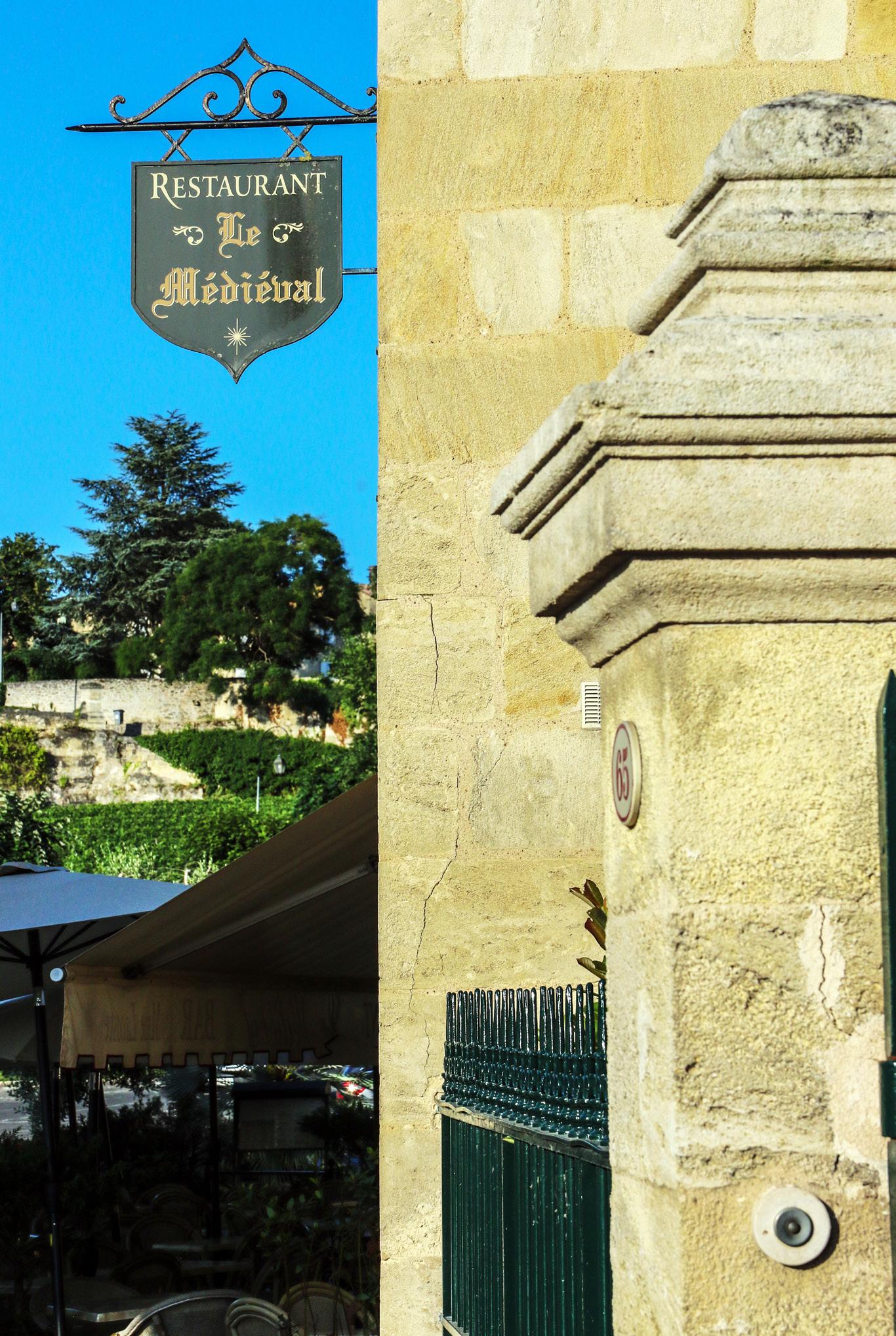



45 WINE COUNTRY INTERNATIONAL Vol. 2 2017
Feature : Saint-Emilion

WINE COUNTRY INTERNATIONAL 46 Vol. 2 2017
Most of its red blends are Merlot- or Cabernet Franc-based, in comparison to the left bank regions that are primarily Cabernet Sauvignon-based. Saint-Emilion is a very large growing area with more than 5,000 hectares (12,355 acres) under vine. It is also a next door neighbor to Pomerol, which is the smallest of all Bordeaux wine appellations.
A few months before our trip, we were introduced to several industry contacts who guided us with suggestions and recommendations. We could not have organized such an intense 3-day visit to Saint-Emilion without the help of Virginie Larramona, Directrice de l’Association de Grands Crus Classés de Saint-Emilion. Virginie assisted with our Chateau visits and gave us amazing restaurant suggestions.
Since its formation in the 1930s, the Saint-Emilion Producers’ Union has grown from a group of six founding winemakers to its current membership of 170 growers. Saint-Emilion has a unique classification system that honors excellence. The most recent classification was in 2012, recognizing 82 properties.

The Saint-Emilion Wine Classification is updated every ten years or so by a special Classification Commission. The changes to a Chateau’s classification are determined by tasting the wines, inspecting properties and taking into consideration the producer’s reputation. The changes are not major in scale, but it is possible for a chateau to be granted an elevation or decrease in classification.
Classification levels:
PREMIERS GRANDS CRUS CLASSÉS (A)
PREMIERS GRANDS CRUS CLASSÉS (B)
GRANDS CRUS CLASSÉS
In 1999, Saint-Emilion was recognized as a UNESCO site for the extraordinary nature of its lively landscape. Driving to and through the town, you will pass by stunning vineyards and numerous ancient sites. The hilltop medieval city is full of wine shops and restaurants. Some of its steep cobblestone streets can be challenging to navigate even if you did not spend an afternoon of wine sipping and chateau hopping.
47 WINE COUNTRY INTERNATIONAL Vol. 2 2017
Feature : Saint-Emilion
Where we visited:
Château Villemaurine - Grand Cru Classe
An historic property with roots dating back to the 7th century. The present property is located near the city center and sits on a vast network of caves or quarries where the wines are cellared. The Chateau offers guided tours of the caves, which make for a unique visit. Its current owner has modernized the winemaking facilities and tasting room. They also have a satellite tasting room located near the city entrance. Their “Privilege” Tour is booked by appointment only and takes 1.5 hours.
Cost: €30
Wine:
2015 Château Villemaurine - 4.5 stars, $45

A blend of 80% Merlot, 20% Cabernet Franc
Deep ruby color with lush cherry fruits, great structure and mouth feel. A great representation of the area’s clay and limestone terroir.
Château Villemaurine
http://www.villemaurine.com/index.php/en/

WINE COUNTRY INTERNATIONAL 48 Vol. 2 2017

Feature : Saint-Emilion

WINE COUNTRY INTERNATIONAL 50 Vol. 2 2017
Château Fonplégade
‘Fonplégade’ means flowing fountain and is named for the fountain located at the center of the property. The fountain is magically fed by four different springs that emerge from the limestone soil behind the Chateau.
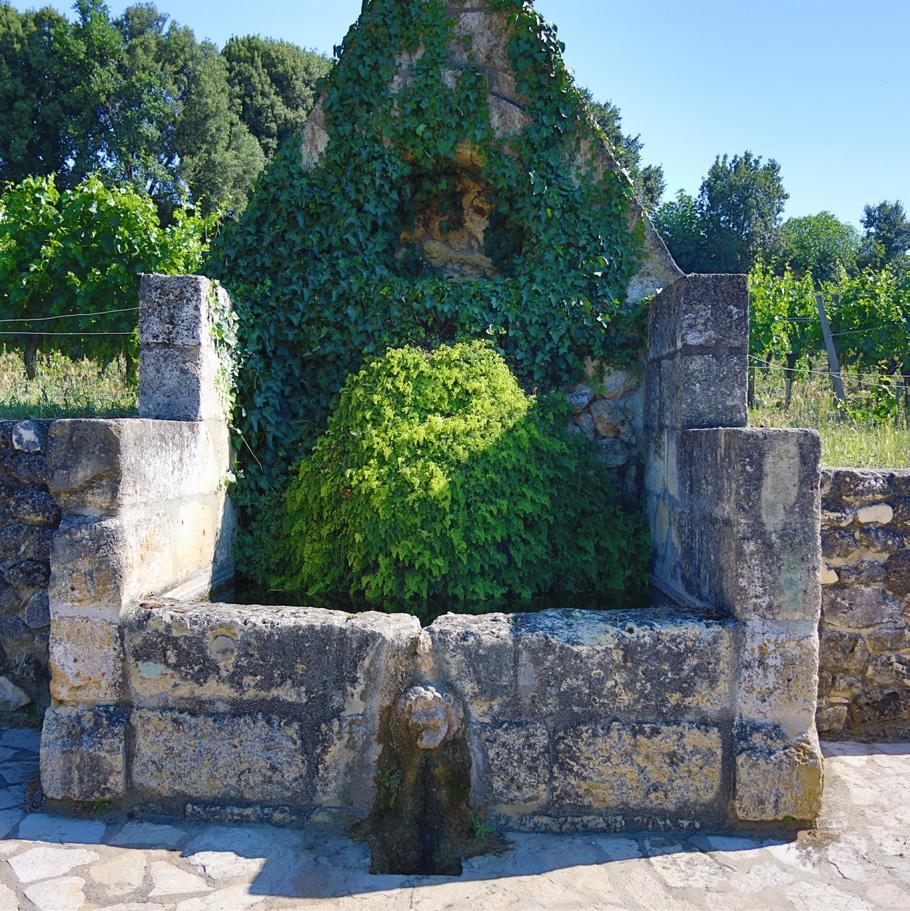
Pulling through the gates of Château Fonplégade and driving toward the stately country house and winery buildings will amaze every visitor. The property was developed in 1852, and over the years the Chateau earned respect for producing some of the finest wines in Saint-Emilion.

Successful business star couple Stephen Adams and his wife, Denise, got the wine bug in California’s Dry Creek Valley in 1995. The couple has a keen love for France and French wines. They purchased Château Fonplégade in 2004 and have invested many resources into improving the property, vineyards and winery. The Adamses have been long-term advocates of organic farming practices. Fonplégade became one of the first estates in SaintEmilion to be farmed organically. In 2013 the Chateau earned full organic certification by ECOCERT.
The winery employs modern winemaking technology and uses custom-designed barrels and fermenters. World-renowned Flying Oenologist Michel Rolland has been involved with Fonplégade since the Adamses took ownership.


Wine:
Château Fonplégade 2012 Grand Cru Classe 2012, 4.75 Stars, $44 95% Merlot, 5% Cabernet Franc
Dark ruby color, complex red fruits, blueberry. Fresh and lively! Long finish.
Château Fonplégade is open every day except Christmas and New Year’s Day.

Château Fonplégade
http://www.fonplegade.com/
51 WINE COUNTRY INTERNATIONAL Vol. 2 2017
Feature : Saint-Emilion

WINE COUNTRY INTERNATIONAL 52 Vol. 2 2017
Clos des Jacobins
Magali and Thibaut Decoster worked in the Bordeaux wine world before becoming owners of two historic Saint-Emilion chateaus in 2004. Clos des Jacobins dates back to the 1700s. The estate is located near the entrance of the medieval town.


The vines are on average 30 years old, but some are as old as 70. The young and energetic Decosters upgraded the winery and offices almost immediately after taking the reins in 2004. They continue to use the consulting services of Hubert de Bouard of Chateau Angelus. In recent years their work in the vineyards has begun to show in the wines. Current production is at 2,000 cases per year.
Clos des Jacobins 2012, 4 Stars, $42 75% Merlot, 22% Cabernet Franc and 3% Cabernet Sauvignon Claret-colored, medium-bodied wine with hints of cocoa and black cherry.
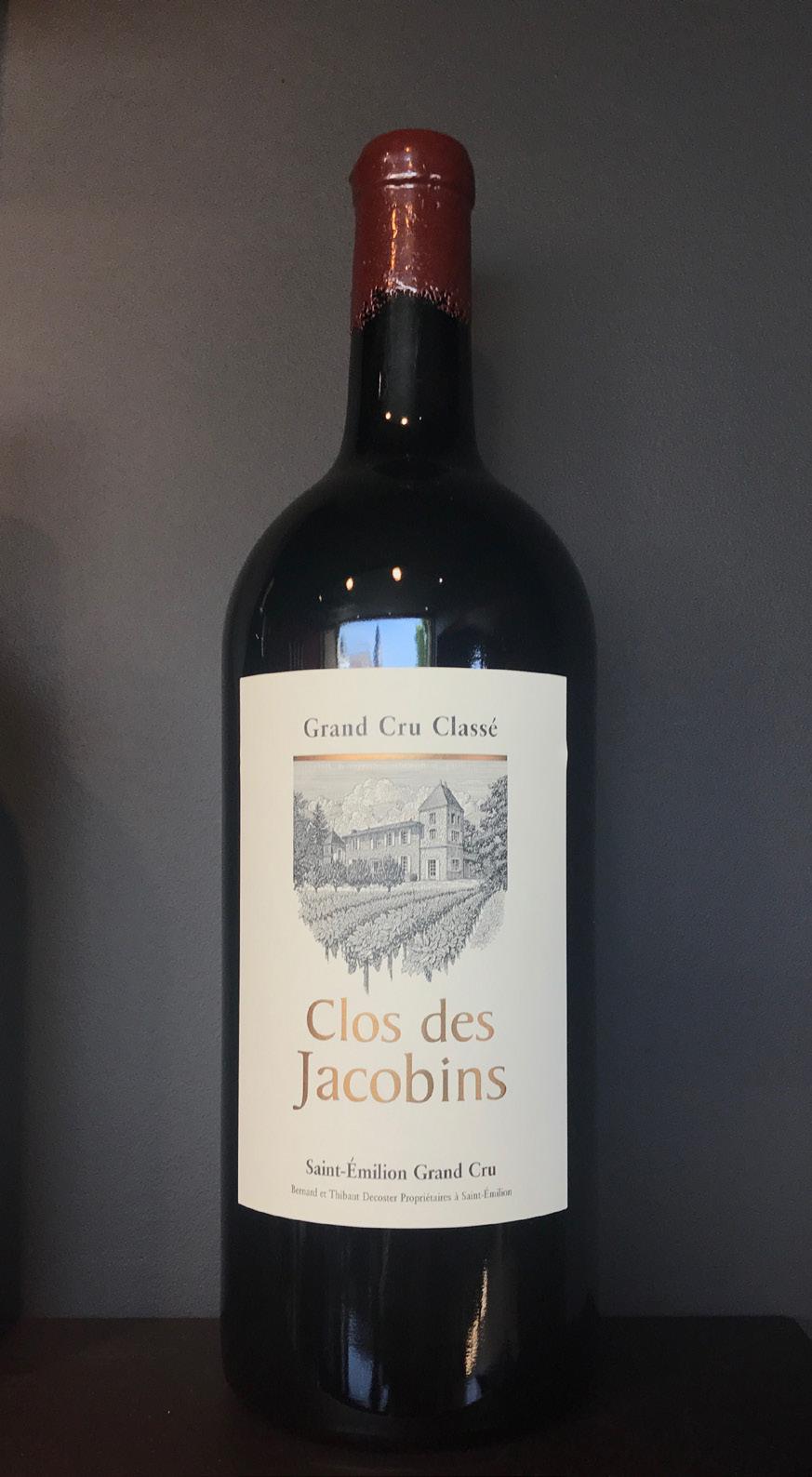
Decanting suggested, cellar for 5 to 10 years.
Clos des Jacobins
http://www.closdesjacobins.com/
53 WINE COUNTRY INTERNATIONAL Vol. 2 2017
Feature : Saint-Emilion

Château Fleur Cardinale

Dominique Decoster is Thibaut Decoster’s uncle. He and his wife Florence purchased the property after selling Dominique’s Limoges porcelain business, Haviland. The Chateau is located on a high plateau east of the medieval town. Château Fleur Cardinale was promoted to the rank of Saint-Emilion Grand Cru Classe in 2006 and confirmed in 2012. The winery is ultra modern and impeccably clean.
Florence and Dominique Decoster now offer four wines:

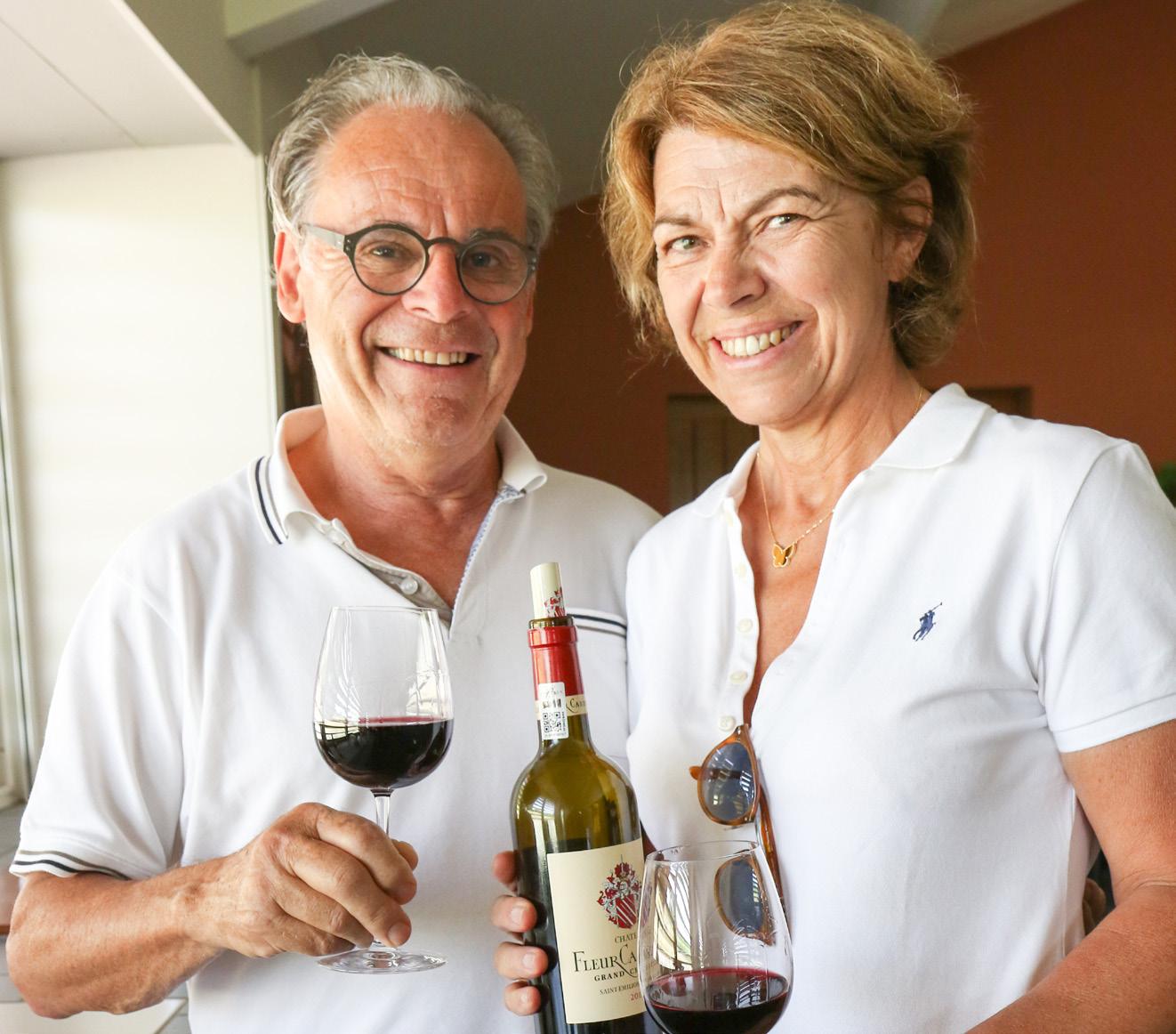
• Chateau Fleur Cardinale Saint Emilion Grand Cru Classe
• Chateau Croix Cardinale, Saint-Emilion Grand Cru
• Secret de Cardinale, Saint-Emilion Grand Cru
• Bois Cardinale, Saint-Emilion Grand Cru
We did not taste these wines but note that most have received ratings of 90 to 94 from Wine Spectator and James Suckling! www.fleurcardinale.com/fr/
WINE COUNTRY INTERNATIONAL 54 Vol. 2 2017
RESERVE Black Pepper BellaVitano
It’s the Best Cheese in the country for a reason.
Creamy & nutty with a peppery bite, Sartori’s Black Pepper BellaVitano is the “Grand Champion” of the U.S. Championship Cheese Contest.

107 N. Pleasant View Road, Plymouth, Wisconsin 53073 www.sartoricheese.com 1.800.558.5888
Feature : Saint-Emilion

WINE COUNTRY INTERNATIONAL 56 Vol. 2 2017
Château
Château Bellefont Belcier was built in 1803. Bellefont, or Belle Fontaine, means beautiful fountain and is inspired by the numerous natural springs in the region. The mansion house is stately and could be the next set for a Disney movie. It has more than a dozen suites, which are used to entertain members of the trade and media. For matters of full disclosure Darcy and I had the pleasure of staying at the Chateau for one night during our visit to the region. The suites are opulent but do not offer air conditioning or fans, which is difficult in the summer. A pool in the backyard offers a quick cool off during Bordeaux’s hot summer nights.
The adjacent winery houses winemaking facilities including the estate’s unique, circular vat house and ultra-modern tasting room. Today Château Bellefont Belcier utilizes the consulting services of world-renowned Flying Oenologist Michel Rolland.
The estate has 20 hectares planted. Production is at 80,000 bottles per year.

60,000 Bottles First Wine
20,000 Bottles Second Wine
Veteran winemaker Emmanuel de Saint Salvy was at the helm for the last 15 years. He recently departed for Clos Fourtet. Château Bellefont Belcier was the first Chateau in Saint-Emilion to be purchased by a Chinese investor.

Dark crimson, stone fruit, dark cherry, creamy leather notes. This is a powerful and well-balanced wine.
www.bellefont-belcier.com/
57 WINE COUNTRY INTERNATIONAL Vol. 2 2017
Bellefont Belcier
Château Bellefont Belcier 2011 Grand Cru Classe, 5 Stars, $40
Feature : Saint-Emilion

WINE COUNTRY INTERNATIONAL 58 Vol. 2 2017
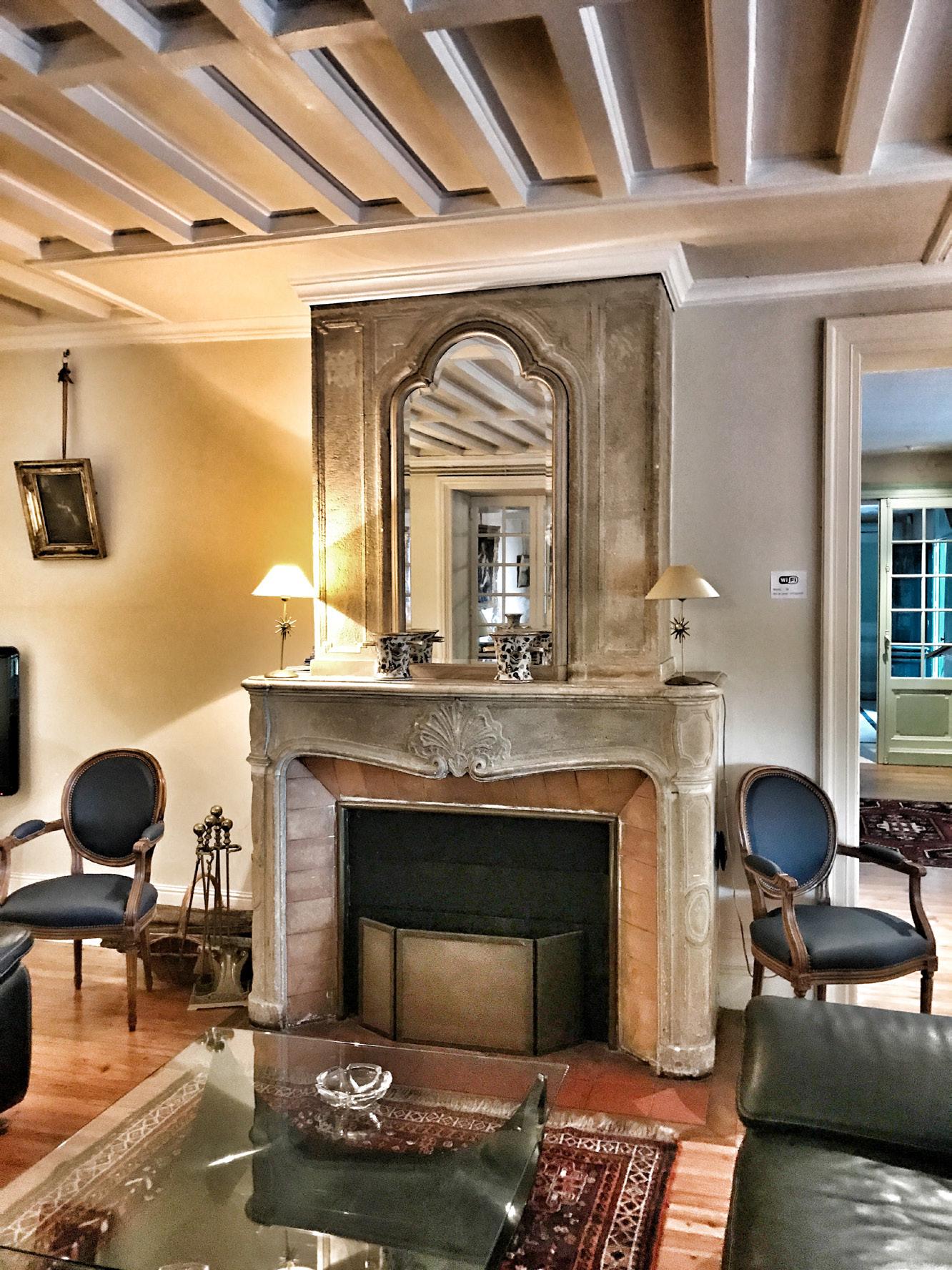



59 WINE COUNTRY INTERNATIONAL Vol. 2 2017
Feature : Saint-Emilion

WINE COUNTRY INTERNATIONAL 60 Vol. 2 2017
Château Dassault
The Château itself was purchased in 1955 by Marcel Dassault. Over the years the family has invested heavily in improving the land and wines. Today Château Dassault has modern winemaking facilities with a Napa-style tasting room. They have a meticulous barrel program, sourcing new barrels made from specific forests. Ageing is done in 75% new oak for 14 to 18 months.
The Château is now owned by Marcel Dassault’s grandson Laurent. A passionate vintner, Laurent controls numerous châteaus in the region. The Château is run by a dynamic winemaker named Laurence Brun, who lives on the estate with her artist husband. She is the daughter of the previous winemaker and grew up knowing the vines and terroir.
During our visit we had the pleasure of joining Laurence and her husband for a splendid home-style lunch consisting of a foie gras and a pork roast. We were joined by Virginie Larramona, Director de l’Association de Grands Crus Classés de Saint-Emilion and winemaker Emmanuel de Saint Salvy of Château Bellefont Belcier. The afternoon of amazing wines, delicious cuisine and interesting conversations will be fondly remembered for years to come!

Chateau Dassault 2007 4.2 Stars, $33
Deep garnet color. Notes of blackberry and dark red fruit. A well integrated, plump wine with medium tannins. A blend of 65% Merlot, 30% Cabernet Franc and 5% Cabernet Sauvignon.
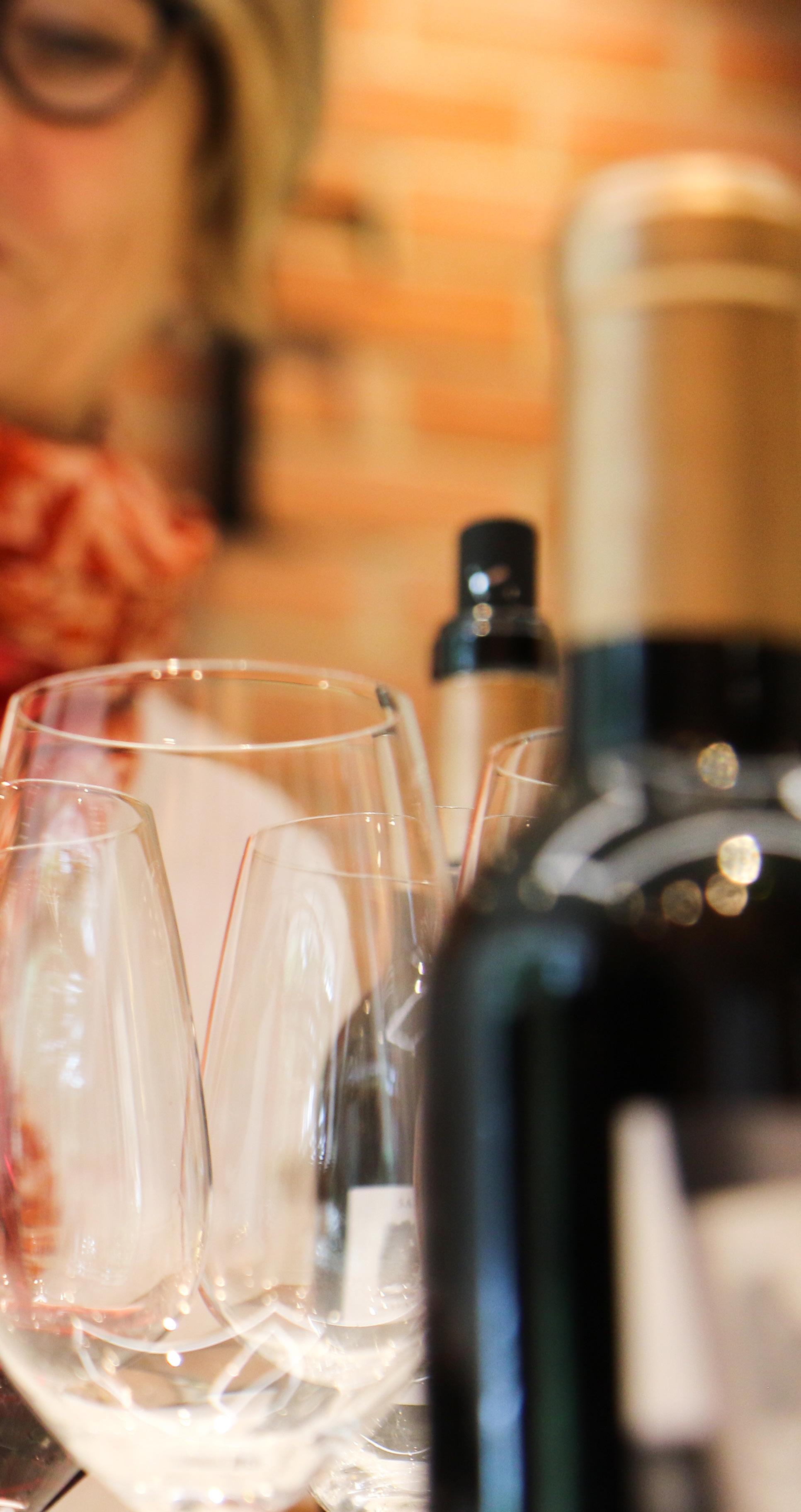
61 WINE COUNTRY INTERNATIONAL Vol. 2 2017
Feature : Saint-Emilion




WINE COUNTRY INTERNATIONAL 62 Vol. 2 2017

63 WINE COUNTRY INTERNATIONAL Vol. 2 2017
Feature : Saint-Emilion
Where To Stay:

If well connected, it is always great to stay at a working Château! The next best option is to stay at Château Grand Barrail Hôtel-RestaurantSpa located on the Route de Libourne just minutes from the medieval city.
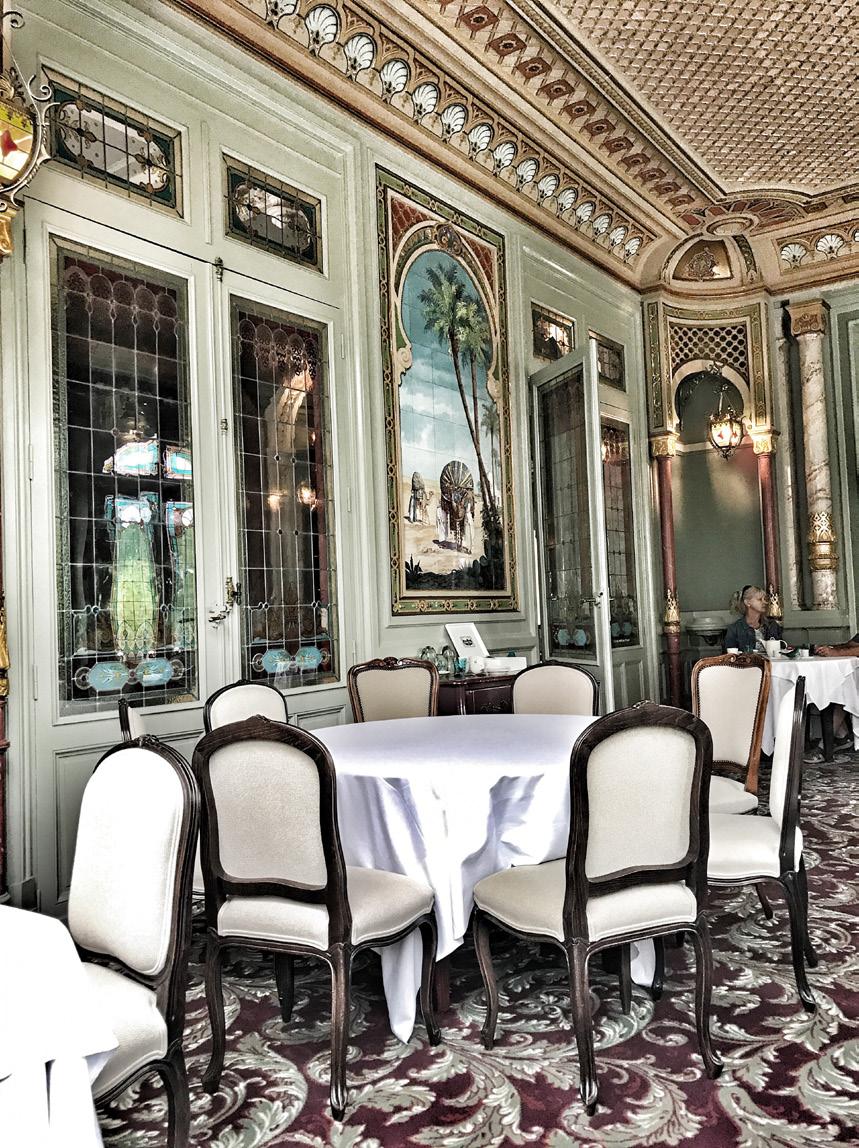

The Château and its outbuildings sit on 7 acres of beautifully maintained grounds, including a swimming pool. We stayed in their Superior Vineyard Room overlooking lush vineyards. The Château has an amazing on-site gourmet restaurant and bar. The dining room reflects a well-appointed, rich style. Dishes include; The Sea Bream Roasted Gold Sea Bream fillet, Pepper Chutney flavored with Lavender, Crunchy Nems Or The Muscovy Duckling Fillet of Duck Cooked Pink, Dry Fruits and Mint Bulgur and Caramelized Parsnip.
Daily Room Cost: €160 to €400 (varies by season)
Château Grand Barrail Hôtel-Restaurant-Spa- 4 Stars!
GRAND BARRAIL – Château Hôtel – Restaurant – Spa
Route de Libourne (D243) 33330 Saint-Emilion

Tel: + 33 (0) 5 57 55 37 00
Email: hotelgrandbarrail@hotels-emeraude.com
Website: http://www.grand-barrail.com/en
WINE COUNTRY INTERNATIONAL 64 Vol. 2 2017

65 WINE COUNTRY INTERNATIONAL Vol. 2 2017
Feature : Saint-Emilion

WINE COUNTRY INTERNATIONAL 66 Vol. 2 2017
Where To Eat:
Le Logis de la Cadène 5 Stars! A “must visit”
One of the oldest restaurants in Saint Emilion, dating back to 1848. It is a favorite among locals as well as tourists. It is located in a small square in the center of town on a steep cobblestone street. The restaurant and 5-room boutique hotel are owned by the family that owns Château Angélus.
In 2017 the restaurant was awarded its first Michelin Star rating. The kitchen is commanded by a young, classically-trained chef Alexandre Baumard. He uses the freshest local ingredients with highly inventive presentations and cooking techniques. We chose the chef’s gastronomic menu with wine pairings. The cost for two people was €220.

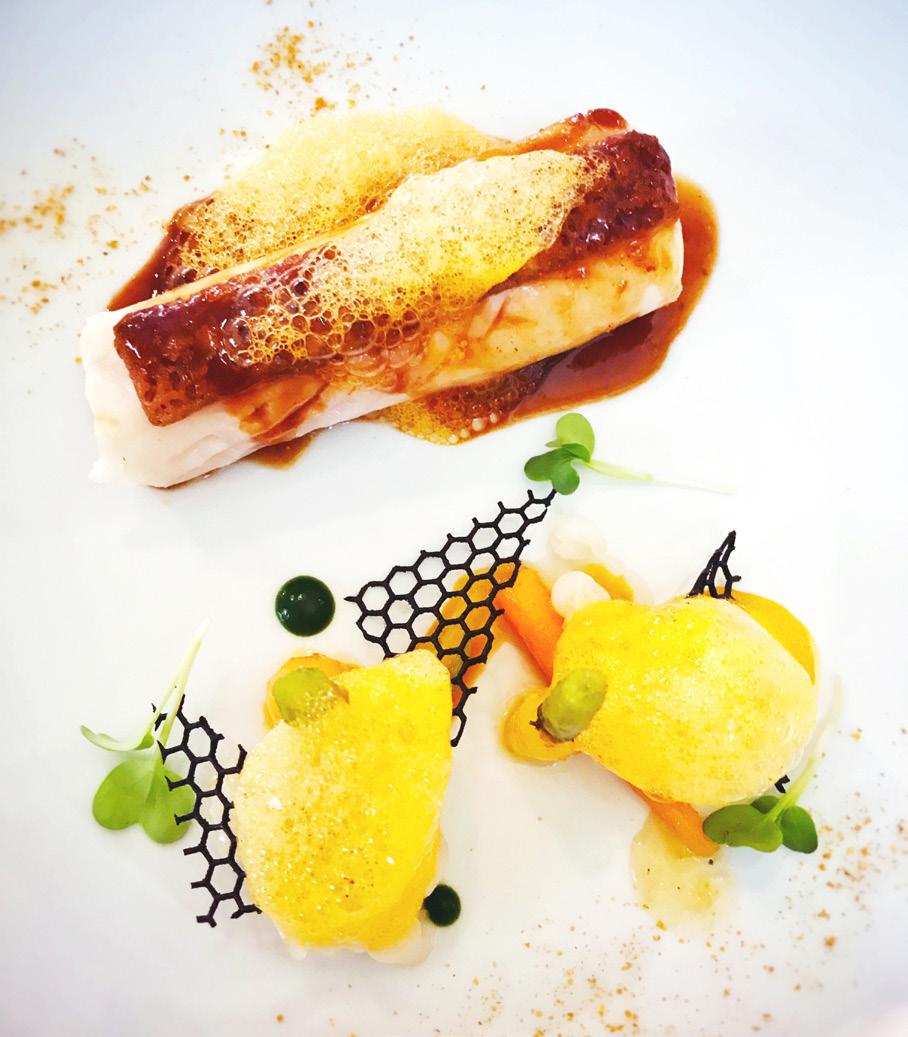
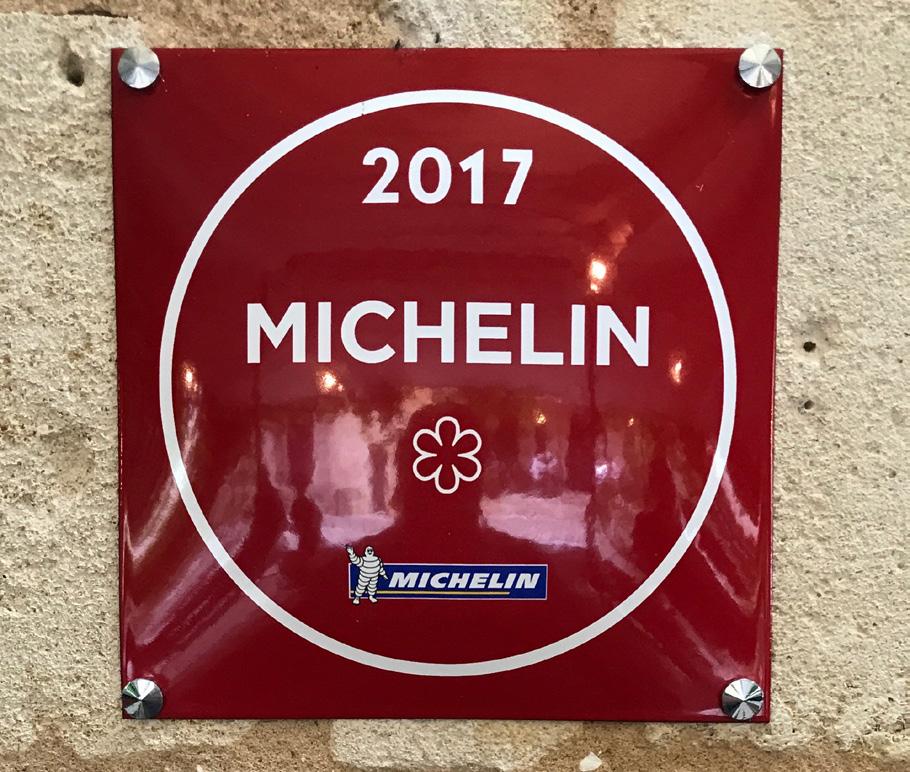


Le Logis de la Cadène

3 Place du Marché au Bois, 33330 Saint-Émilion
http://www.logisdelacadene.fr/en/
67 WINE COUNTRY INTERNATIONAL Vol. 2 2017
Feature : Saint-Emilion

La Terrasse Rouge 4.5 Stars!
La Terrasse Rouge is a wonderful restaurant located on the upper level of the modern Château La Dominique winery. It features southwestern French Cuisine with a fantastic view of the vineyards. In the summer, they open the glass doors to the rooftop deck, which is popular with the bar patrons.
The restaurant features duck and fish dishes, but steak is the most popular entrée.


The wine list is extensively French.
La Terrasse Rouge 4.5 Stars!
1 Château la Dominique
33330 Saint-Émilion – FRANCE
http://www.laterrasserouge.com/
WINE COUNTRY INTERNATIONAL 68 Vol. 2 2017
Atelier de Candale 5 Stars!
This is a gem of a restaurant located in the heart of Saint-Emilion’s wine country. The building is a well-appointed mini-castle. In the summer, they offer outdoor dining under their massive canopy. The highly creative chefs turn out dishes that are as visually stimulating as they are delicious. Open for lunch or dinner.


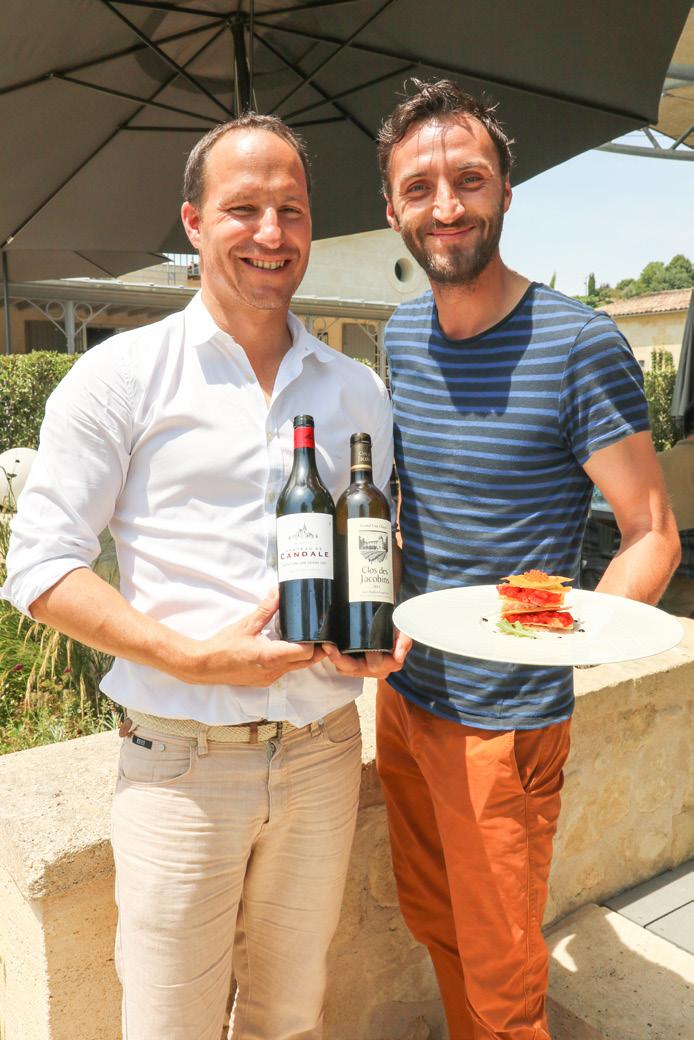
Atelier de Candale
1 Allee Grandes Plantes
33330 Saint-Laurent-des-Combes, France
http://atelier-de-candale.fr/en/


69 WINE COUNTRY INTERNATIONAL Vol. 2 2017
Warren Winiarski
Beyond The Judgment of Paris
Story and photos by Christopher and Darcy Davies
Forty-one years ago, the Judgment of Paris forever changed the world of wine in California, when Warren Winiarski’s Stag’s Leap Wine Cellars 1973 Cabernet Sauvignon was named best red wine, making French vintners run for cover in disbelief. In the years thereafter, while enjoying enormous commercial success, Winiarski has become the number one champion for the California wine industry, as well as a benevolent supporter of many agricultural and local causes.
We caught up with Warren after his return from the 41st reenactment of The Judgment of Paris in Tokyo, where California wines showed their aging stature had remained stronger than ever.
Our interview was initially scheduled as a lunch, but since our flight was delayed due to fog, we had the honor of meeting Warren at his home above Stag’s Leap Wine Cellars.

WINE COUNTRY INTERNATIONAL 70 Vol. 2 2017 Passion & Portraits

71 WINE COUNTRY INTERNATIONAL Vol. 2 2017
Passion & Portraits
Warren Winiarski Interview
June 9, 2017
Conducted at Warren Winiarski’s home in Napa, California.

CD: Here we are, the founders of Wine Country International magazine in the lovely home of Warren Winiarski (pronounced Viniarski). How are you doing?
WW: I am doing fine. Thank you.
CD: We really appreciate your patience with us since our flight was delayed. This is probably better than trying to do the interview at a restaurant. Plus we have this lovely view of the Fay Vineyard in the distance.
CD: Let’s get some of the past out of the way. Since you have so much going on now. Let’s talk about the 41st Judgment of Paris. How did Stag’s Leap Wine Cellars get invited? How did they contact you?
WW: It was the Napa Valley Vintners that invited me to be their representative at the tasting. I was a taster but my reckoning did not count.
There were about nine tasters as I recall. Two were Americans. Two French people associated with the trade. And the balance of the five were all Japanese. All were wine professionals. They did the tasting. Their scores were counted. We were observer tasters.

CD: Where did this tasting take place?
WW: In Tokyo, at the Tokyo American Hotel.
CD: This was the most recent tasting. The 41st reenactment of the original Red Judgment of Paris tasting?
CD: You said that Napa Valley did very well.
WW: Napa Valley came out on top again. I was very proud of those wines.
They are all changing on any given day. But Freemark Abbey Cabernet Sauvignon came out on top! It was actually a 1969. I think that it was the oldest in that group.
CD: It looks that way. 153 points. That is the total points given by all of the judges combined?
WW: Yes. It was on a 20-point scale.
CD: And Mayacamus 1971 received a 147 score.
And then a 1970 Chateau Mouton Rothschild received 146.5. That’s pretty amazing! Stag’s Leap made the list too with a 133. Wow!
WW: What did it prove? It means that wines made well in the Napa Valley can age just as well as a French wine! There was some supposition that only the French wines can age well. And over time being the aristocrats and having sacred soil to grow in there would be some change in that supposition. You have to believe that after forty years that California wines can age very well.
CD: I am glad that everybody held onto those bottles! That is a significant achievement.
WINE COUNTRY INTERNATIONAL 72 Vol. 2 2017
Photos (L to R) Judgement of Paris tasting, photo courtesy of Bella Spurrier, Warren Winiarski in his study, photo by Christopher J. Davies
CD: So tell me looking back at the original Judgment of Paris and its success for California wines. Did this have a big affect on luring people into the wine business?
WW: Possibly. But more importantly it gave us reason to not be reluctant to strive for the highest status for our wines. Perhaps that’s the biggest lesson from that tasting.
WW: In the past, not so distant past, it was believed that French wines were at the top of any category of red wine. And that was put to rest with the Paris tasting. Because people all over the world had higher aspirations and they were encouraged to be attentive to the details. They were no longer limited by an artificial hierarchy which in fact did not exist. The wine-drinking public benefited because each region had higher aspirations for their wines.
CD: So back at the original Judgment of Paris the white wine that won was a Chateau Montelena?
WW: Yes
CD: Being a red wine producer, what do you think about the big strides in popularity and sales of Rosé wines?
WW: It is very interesting. Consumers shift. But there are certain standbys in structural things. Refreshing wines? Yes. Appetizing wines? Yes. Go with a lot of foods? Yes.
All those things are positive. I think that the shift to Rosé wines should not be taken negatively. Because people will look for a taste experience that they can only have with great whites or great reds.
CD: I was reading in France that they drink more Rosé than white wines nowadays.
WW: I didn’t know that. And you threw out France. I guess they are building a consumer base.
CD: I hear that you are part of a wine dinner in Washington D.C?
WW: I am part of it. Last year was the 40th celebration of the Paris tasting.
This year’s dinner was an interesting one. I have a booklet from that tasting that was honoring Mexican-American winemakers.
The Mexican-Americans have been a very big part of the development of wine in California. And I felt that it was time to sponsor a dinner where they could appear and show their wines. We sponsored five Mexican-Americans that also had aspirations that were encouraged by the industry.


One of them, Roland Herrera started here and his first job was cracking bricks for the stones that went into this house. He looked at me a certain way. I saw something in his eye that said this man is not going to stay around cracking bricks for the rest of his occupational life.
I hired him after his job to come into the winery. And he worked for us for almost three decades before he started his own enterprise.
73 WINE COUNTRY INTERNATIONAL Vol. 2 2017
Passion & Portraits
DD: What has been the biggest change in viticulture from when you started to now?
WW: In the old times vineyard vines were on 8x8 spacing. So that you could cultivate two ways. Then agronomics came in. And the economy of spacing became important to maximize your efficiency. So you wanted to have the fewest vines that could make the greatest crop. So you could make a few turns in the vineyard. These types of agronomics came into play. That was the first revolution.
Then we focused on roughly 400 vines per acre. No one asked if this made better wines. Rather was it more efficient? The vines got very big. They produced more fruit. But not better fruit. They were efficient nonetheless.
This put vines in a death spiral as the vines developed a lot of leaves and less fruit taking away energy.
The second revolution came when we put the vines on less vigorous rootstock. And closer together to get rid of the energy… or the photosynthetic energy that was accumulating in the vines. With the vines closer, that made a big difference in quality. So nowadays we focus on what is the best way to produce the fruit and not on how many times the tractor has to turn.
Warren Winiarski holding booklet that recognizes Mexican American winemakers.
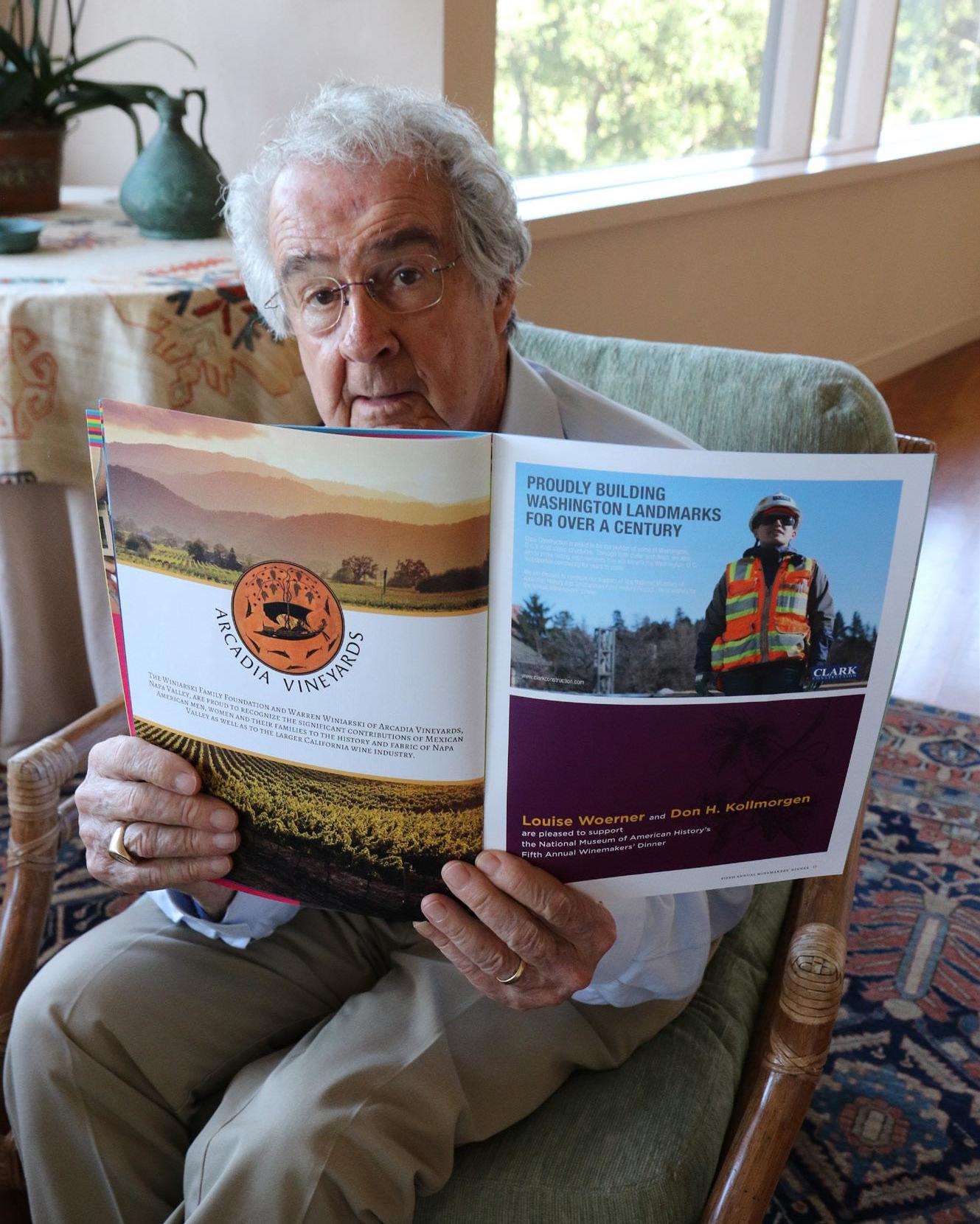
Group photo (L to R)
Lorin Bramble and JoAnn Bramble with Gustavo Bramble, Owner & Winemaker, Gustavo Wine, John Gray, Director of the Smithsonian’s National Museum of American History, Reynaldo Robledo with Leticia Trejo-Vargas, Dalia Ceja and Amelia Morán Ceja, President & Owner, Ceja Vineyards, Chef Pati Jinich, Culinary Consultant, Warren Winiarski, Arcadia Vineyards, Lidia Maldonado with Hugo Maldonado, Owner & Winemaker, Maldonado Vineyards, Lazaro Robledo, Robledo Family Vineyards, Lorena Herrera with Rolando Herrera, Proprietor & Winemaker, Mi Sueño Winery

WINE COUNTRY INTERNATIONAL 74 Vol. 2 2017




75 WINE COUNTRY INTERNATIONAL Vol. 2 2017 From Western Slope train journeys to European river cruises, AAA Travel makes your culinary travel dreams come true. Discover a world of possibilities with AAA, proudly serving Colorado residents since 1922. Imagine Yourself Here Contact a AAA Travel Agent today to plan your next culinary adventure. 866-975-9583 | AAA.com
Our team of certified sommeliers scour the world’s best vineyards to hand select a wine collection unlike any other at sea. The result is a selection that has swept the Wine Spectator Restaurant Awards five years in a row, racking up 48 awards—more than any other cruise line. Because dishes crafted by our Michelin-starred chef should be paired with nothing less.
Celebrity Cruises is proud to sponsor the Denver International Wine Festival. 1-800-CELEBRITY | celebrity.com | Call your travel agent
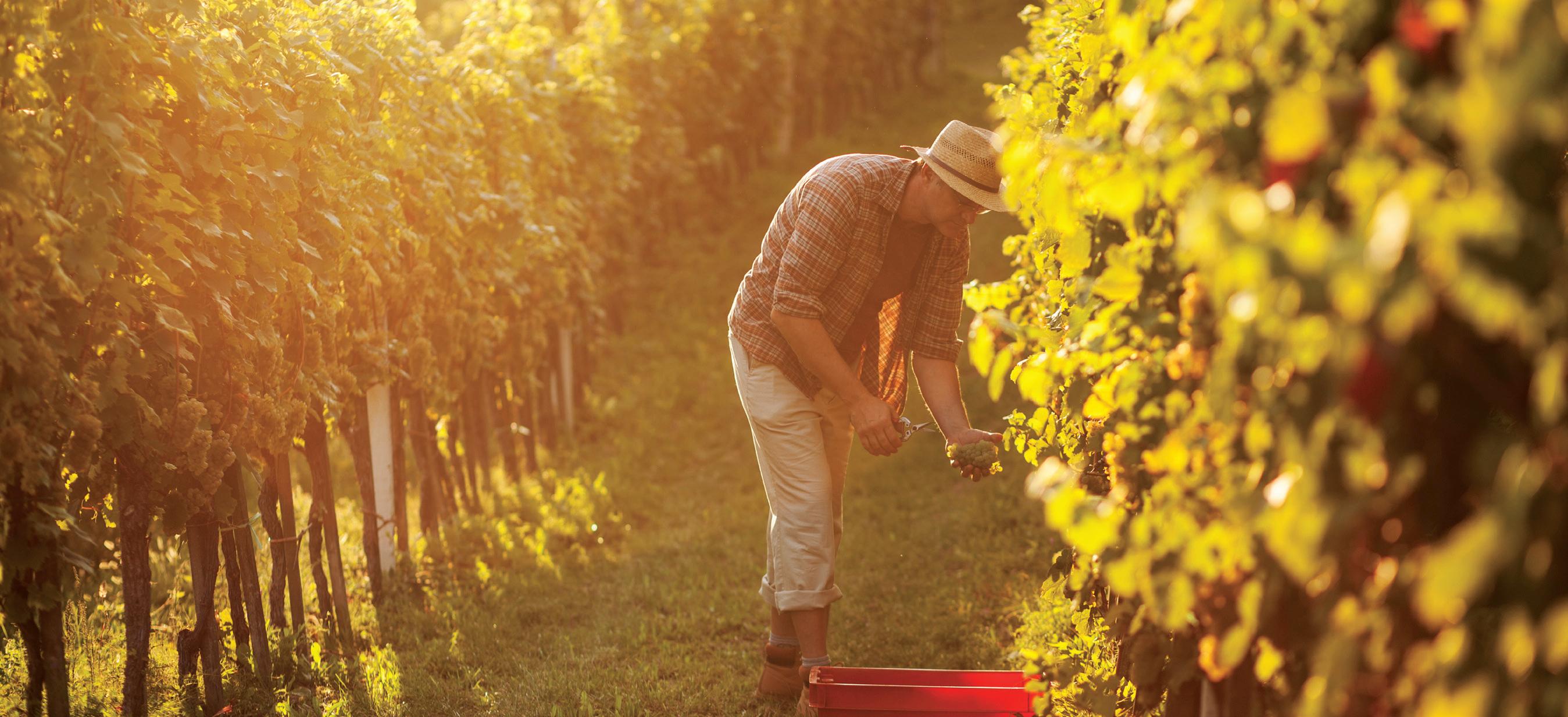

The sommelier-selected, multi-million-dollar, floating wine collection you deserve.
©2017 Celebrity Cruises. Ships' registry: Malta and Ecuador.
Parting Shots
Cover Feature: Lodi, California
It has been about a decade since we created significant coverage on Lodi.
This important, but less popular wine country tourist destination is located 100 miles east of San Francisco, about the same distance as San Francisco to Napa.


A lot has changed since we featured Lodi as the “quiet Napa.” Several producers have retired and passed on, while a number of new passionate vintners have settled in the region, creating exciting new wines.


It is still a lot less congested and less commercial than Napa, but the focus of the growers has changed full circle. And while Lodi vineyards produce 40% of all zinfandel grapes grown in California, Lodi winemakers are no longer gulping the zin Kool-Aid. More than 160 varietals have been deemed suitable for growing in Lodi’s Mediterranean climate.
It is no surprise that some wine industry veterans are considering making a move from corporateintense Napa and Sonoma to a more artisanal winemaking Lodi. The culinary scene was elevated to new heights recently when Chef Bradley Ogden, a James Beard Award-winning culinary master, relocated to the area and became a consultant to the Wine & Roses Town House Restaurant. Lodi has evolved into a respectable wine destination with easy access to winemakers, more affordable wines and excellent lodging possibilities.
77 WINE COUNTRY INTERNATIONAL Vol. 2 2017
YOUR ATTITUDE-FREE PASSPORT TO GREAT WINE & DELICIOUS FOOD 2017/3






Try Our Refreshing, Award-Winning, Locally Sourced Eldorado Natural Spring Water. Plans.EldoradoSprings.com





















































































































































































 By Ron Kapon
By Ron Kapon





















































































































































































